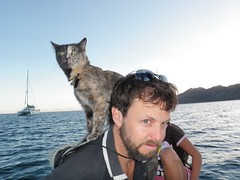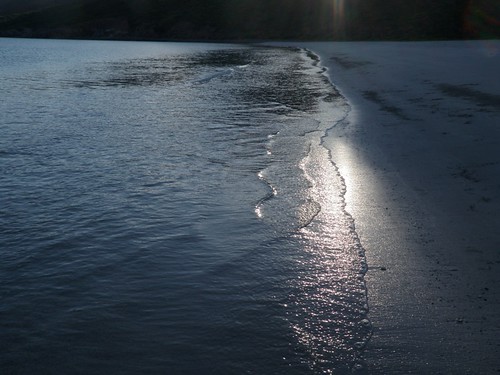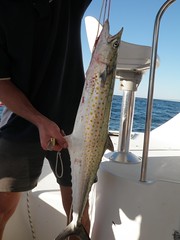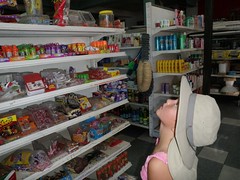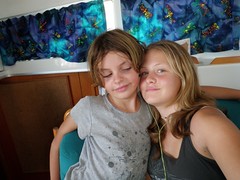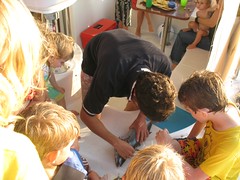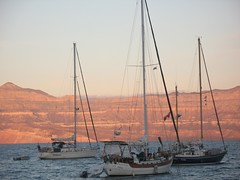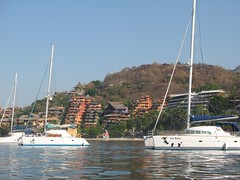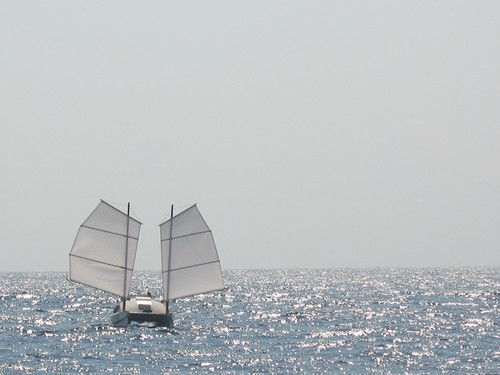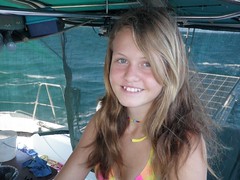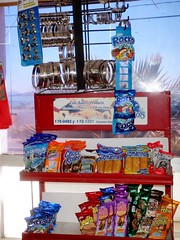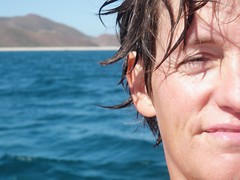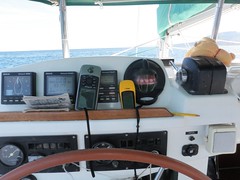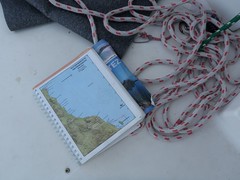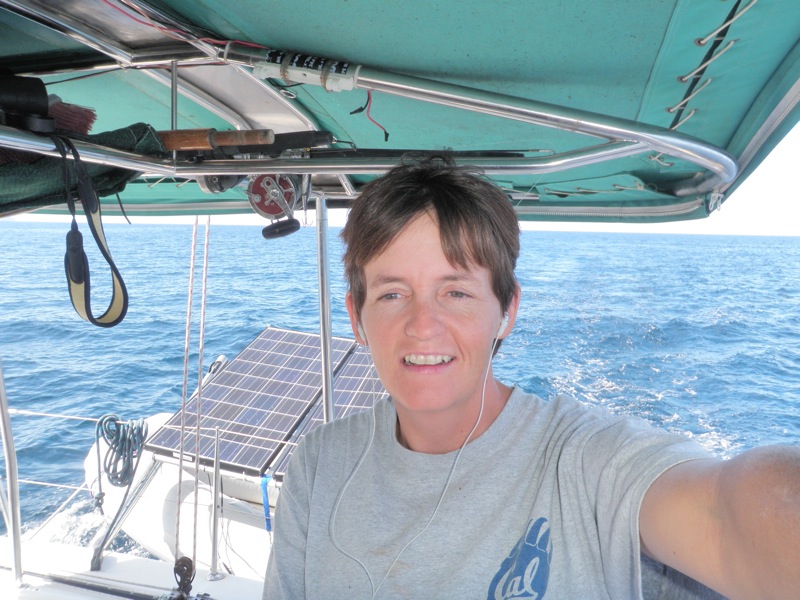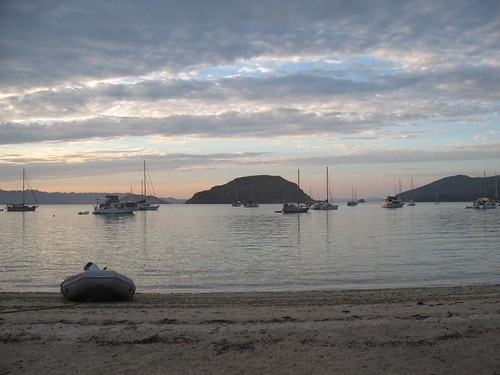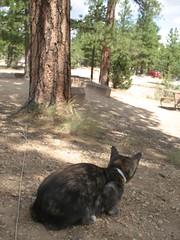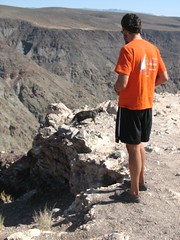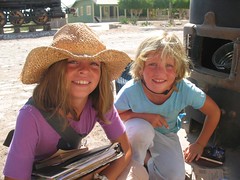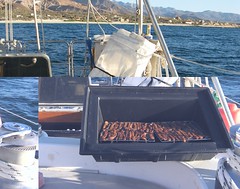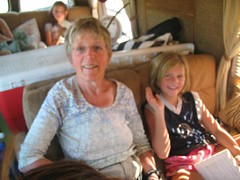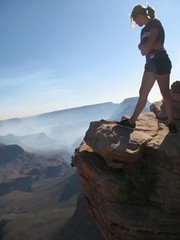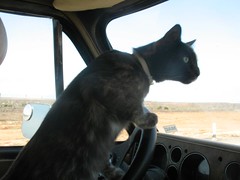A few mornings before Christmas, I woke suddenly and completely with a thought big and crystal clear in my head: We need to sell Don Quixote. I turned to my sleepy husband and pounced on him with this idea. DrC is not clear headed in the morning. Like most men, he can think of only a two things when awakened. One of them is coffee. If I were to get his full attention, it required that I dispose with these ideas first.
Moving on, the idea of selling Don Quixote fell on fertile emotional soil. We had seriously been noodling leasing her, but the logistics were a nightmare. Putting her on the hard for a year means a lot of expense and slow degradation of the boat without any real return to us. If we planned to cruise for several years after New Zealand, it would make sense to keep her. However, as I've mentioned before, we do not have that much cruising kitty left... maybe a year at most. Jaime is getting long in the tooth for cruising, Aeron would like to spend longer chunks of time in single locations. This summer tempted all of us with a glimpse of a nomadic land life. The absence of Don Quixote in our life would be a financial relief, but it could also be the lifting of a burden enabling us to consider completely different adventures going forward.
Christmas Day found me on the deck of s/v Totem talking with our good friends Behan and Jamie. We were discussing all the options for the future, New Zealand paperwork, and teenagers. Without any prompting, Totem asked me, “Have you thought about selling Don Quixote?” I was struck by this coincidence. Prior to this not a single soul – online or nautical – had asked me whether or not we wanted to sell her. In the cruising world in particular, boat selling and ending the cruising life are topics that no one brings up unless the owner opens the subject. I think it might be taboo. Yet, here was Totem asking about selling Don Quixote before I said anything.
“Why yes... we had just started thinking about it. But it seems... it seems like a really big idea.” I'm almost babbling.
Jaime was less sanguine. When we broached the idea with the girls, we met with mixed reactions. Jaime cried. In her deeply contemplative fashion, Mera thought about the idea and informed us that this made a great deal of sense. She was ready for a new experience. Aeron vacillated back and forth but was largely concerned about Dulcinea's reaction.
This is as far as we'd gotten when a note arrived in my Inbox three days later from a couple we'd met in the Sea of Cortez last summer. “Remember us? We're planning on cruising this fall, and we heard about New Zealand. Would you consider selling or leasing Don Quixote?”
Rule of Three* strikes again.
So if you asked me two weeks ago if we'd sell Don Quixote, I would have said, “Hell no!” And if you ask me today, I'm going to say, “What are you offering?”
The immediate plans do not change. We spend the next two weeks moving the boat back to La Paz. There we are going to clean and empty her out since – whether sold or on the hard – she needs to be empty and clean. Then we'll haul her, paint her bottom, and get a survey done. Again, this must be done. We can't sell her like she is, and we can't leave her on the hard without a new survey for insurance reasons.
But we'll also be exploring all the many varied options of how you list and sell a boat without spending a fortune. The first is, of course, the ubiquitous hive mind of my blog, Twitter feed, and Facebook account. If you know of anyone considering buying a Lagoon 380 in the Pacific, tell them now is the time to do so. There are very few of us out here, they rarely go on sale, and when they do, the owners are rarely as motivated and willing to do a good deal as we are. We will put together a web page with her specifications and equipment over the next week, and get it out to the hive mind with a URL as soon as possible.
The other thing that does not change is our status of “floating.” If cruising is way of thinking, a form of living without traditional boundaries and in a liquid state of adaptive learning, we continue our cruising life for the foreseeable future. Even without Don Quixote, we can cruise in a tramper in New Zealand or Australia, by train in Europe, via R.V in the United States. We can hike, bike, or park. Ironically, the cruising kitty can sustain us for many more years if we simply change the mode of transportation: Our boat is beautiful but like every boat afloat she is a black hole into which you pour money.
I think we needed the comfort and spacious beauty of our Lagoon catamaran to get us out of our incredibly plush, capacious and comfortable land lives. After nearly three years of living on her and two years of moving her from place to place, however, we know how to live much larger with much smaller accommodations, how to do a lot more with a lot less.
Believe it or not, the Conger family is ready to downsize and purge. Again.
* Rule of Three – If three things happen in quick succession that point you towards or away from a certain course of action, the Fates are trying to tell you something. It is a very good idea that you listen and obey.
Thursday, December 31, 2009
Saturday, December 26, 2009
Questions from the Class - Don't You Get Stir Crazy?
A fellow doctor interested in our experience on the boat and with getting a locums position in New Zealand passed on these questions from his wife: How did you not go stir crazy on the boat? Did you not feel that you were on top of each other?
My flip response is: Yeah, a boat is small, but you've got the biggest back yard in the entire world.
But this doesn’t get to the heart of her question. I truly believe that when people ask me this question it is less about how we cruising families can live on boats and more about how land based families can give up the comforts of home. It is a scary world outside the secure box we’ve been trained to build and maintain for ourselves and our loved ones. With a house in the suburbs, we have some degree of security and a great deal of familiarity with the rhythms, the requirements, the dangers, and the pleasures. Once we step off the porch and into the street, we are lost in a world of possibilities, not all of which are manageable and most of which are completely unfamiliar.
The way you move a family on to a boat is the way you must do everything in life. First, commit your whole being to the project. You -are- going to do this thing, whether it is getting on a boat and sailing away, climbing into an R.V. and driving around the country, or stepping on to a plane and moving to another country. This is, without question, the hardest step. Everything else is details. To make the commitment, you must believe with all your being that you are doing the right thing for yourself and your loved ones. You can’t go into this half-assed. This is why I object so strongly to the dragged aboard spouse. All members of the family must understand and agree to the endeavor, or it will not be successful. Over and over we’ve seen boats fail and go home because one or more of the crew just wasn’t committed to the life.
With all members of the family on board, you must build your walls against FUD: Fear. Uncertainty. Doubt. These will plague you. Worse, your family, your friends, your colleagues at work and at school will question you. Many will be supportive on the surface, but underneath, their attitude distills to this expression of doubt: What the hell do think you are doing? Challenges to your decision are couched as concerns for your safety, for the well-being and health of your children, for the “socialization and education” of your off spring. You’ll get questions about road bandits, pirates, drug lords, murderers, swine flu, bad water, and storms. Everyone will be “impressed with your courage” and “would love to do something like that” themselves, but you’ll feel the subtext. Your decision challenges the foundation of their existence, their reason for getting up each morning, taking their children to the local public school, going to work, and voting the first week of every other November. And by doing so you are, in some fundamental way, the Enemy. Questioning your choices is their defense. Calm, patient, well-researched responses to the endless what-ifs is your way of making sure that those fears do not undermine your own decision making process.
Then, make a project plan to get you from Point A to Point B. Set dates. Make those dates as specific as possible. Set objectives. Make those objectives as concrete as possible. “Start homeschooling” is too vague. “Withdraw the kids from school March 3, 2010” is much better. To the extent that your funds and situation allow, try to phase the lifestyle changes over the course of several months or even years. In our family, I quit my job, six months later the kids quit school, four months passed and we moved from a 3,000 sq ft house to an 800 sq ft basement, another four months and we moved on to the boat, then three months later my husband quit his job and we left Seattle. By adapting to each major change, we made the entire process less overwhelming.
While you implement your project, let go. Let go of everything. Let go of all the Things that own you. Let go of all the assumptions you have about what you are and why you exist on this planet to serve the greater good of the American (or Canadian or British) economy. At each phase, challenge yourself and your spouse and your children to get rid of baggage: physical and mental. Discover the freedom of not owning stuff. Revel in the wonderful world that is your children’s imagination. Explore the inner voice that enjoys bedroom activities with the spouse, kneading bread, or knitting. Rediscover how good your loved ones smell, even after they have been working, playing, sweating, swimming. Let yourself get dirty.
And now that you are here... at Point B on the boat, in the R.V., settled in Australia, Canada, the UK, New Zealand, Mexico, wherever. Now that you are here... ask yourself these questions again: How do you not go stir crazy on the boat? Don’t you feel that you are on top of each other?
The only time we go stir crazy on the boat is when we are pinned down for several days due to weather and can’t get ashore or in the water. After about the third day, we’re all absolutely mad to get some really vigorous exercise.
Our boat is plenty big enough for everyone. We rattle around and only occasionally knock into one another. We’ve never met a committed cruising family who didn’t adapt their lifestyle -- more or less successfully -- to their boat, no matter how small the craft. We get in each other’s way when cleaning, sometimes when cooking, and occasionally when sneaking up to the salon to stuff stockings on Christmas Eve.
You’ll be fine. You’re going to be successful, too.
![]()
My flip response is: Yeah, a boat is small, but you've got the biggest back yard in the entire world.
But this doesn’t get to the heart of her question. I truly believe that when people ask me this question it is less about how we cruising families can live on boats and more about how land based families can give up the comforts of home. It is a scary world outside the secure box we’ve been trained to build and maintain for ourselves and our loved ones. With a house in the suburbs, we have some degree of security and a great deal of familiarity with the rhythms, the requirements, the dangers, and the pleasures. Once we step off the porch and into the street, we are lost in a world of possibilities, not all of which are manageable and most of which are completely unfamiliar.
The way you move a family on to a boat is the way you must do everything in life. First, commit your whole being to the project. You -are- going to do this thing, whether it is getting on a boat and sailing away, climbing into an R.V. and driving around the country, or stepping on to a plane and moving to another country. This is, without question, the hardest step. Everything else is details. To make the commitment, you must believe with all your being that you are doing the right thing for yourself and your loved ones. You can’t go into this half-assed. This is why I object so strongly to the dragged aboard spouse. All members of the family must understand and agree to the endeavor, or it will not be successful. Over and over we’ve seen boats fail and go home because one or more of the crew just wasn’t committed to the life.
With all members of the family on board, you must build your walls against FUD: Fear. Uncertainty. Doubt. These will plague you. Worse, your family, your friends, your colleagues at work and at school will question you. Many will be supportive on the surface, but underneath, their attitude distills to this expression of doubt: What the hell do think you are doing? Challenges to your decision are couched as concerns for your safety, for the well-being and health of your children, for the “socialization and education” of your off spring. You’ll get questions about road bandits, pirates, drug lords, murderers, swine flu, bad water, and storms. Everyone will be “impressed with your courage” and “would love to do something like that” themselves, but you’ll feel the subtext. Your decision challenges the foundation of their existence, their reason for getting up each morning, taking their children to the local public school, going to work, and voting the first week of every other November. And by doing so you are, in some fundamental way, the Enemy. Questioning your choices is their defense. Calm, patient, well-researched responses to the endless what-ifs is your way of making sure that those fears do not undermine your own decision making process.
Then, make a project plan to get you from Point A to Point B. Set dates. Make those dates as specific as possible. Set objectives. Make those objectives as concrete as possible. “Start homeschooling” is too vague. “Withdraw the kids from school March 3, 2010” is much better. To the extent that your funds and situation allow, try to phase the lifestyle changes over the course of several months or even years. In our family, I quit my job, six months later the kids quit school, four months passed and we moved from a 3,000 sq ft house to an 800 sq ft basement, another four months and we moved on to the boat, then three months later my husband quit his job and we left Seattle. By adapting to each major change, we made the entire process less overwhelming.
While you implement your project, let go. Let go of everything. Let go of all the Things that own you. Let go of all the assumptions you have about what you are and why you exist on this planet to serve the greater good of the American (or Canadian or British) economy. At each phase, challenge yourself and your spouse and your children to get rid of baggage: physical and mental. Discover the freedom of not owning stuff. Revel in the wonderful world that is your children’s imagination. Explore the inner voice that enjoys bedroom activities with the spouse, kneading bread, or knitting. Rediscover how good your loved ones smell, even after they have been working, playing, sweating, swimming. Let yourself get dirty.
And now that you are here... at Point B on the boat, in the R.V., settled in Australia, Canada, the UK, New Zealand, Mexico, wherever. Now that you are here... ask yourself these questions again: How do you not go stir crazy on the boat? Don’t you feel that you are on top of each other?
The only time we go stir crazy on the boat is when we are pinned down for several days due to weather and can’t get ashore or in the water. After about the third day, we’re all absolutely mad to get some really vigorous exercise.
Our boat is plenty big enough for everyone. We rattle around and only occasionally knock into one another. We’ve never met a committed cruising family who didn’t adapt their lifestyle -- more or less successfully -- to their boat, no matter how small the craft. We get in each other’s way when cleaning, sometimes when cooking, and occasionally when sneaking up to the salon to stuff stockings on Christmas Eve.
You’ll be fine. You’re going to be successful, too.
Tuesday, December 22, 2009
I'm Baking
“Jaime! What are you doing?! Get out of that!” I growl menacingly at my eldest daughter who is hovering over the stove.
“It's okay, Mom. I'm just testing them. It's been awhile since you made them. Maybe you didn't do it right,” she attempts to soothe me.
But I know what she's up to. I know my daughter. I know everything about my offspring. “Get OUT of the rolls. They are perfect. Back away from the rolls. Back away slowly,” I warn.
All three girls giggle as I advance on the galley with a deck brush raised in warning. Aeron and Mera attempt to divert me while Jaime slides three piping hot garlic rolls out of the pan and juggles them as she disappears into the port hull. My feints and dodges do no good, and the thieves disappear into a garlic and olive oil induced coma in their cabins.
The temperature mercifully dropped below 100 a few weeks ago, so I started baking again. I didn't know I loved to bake before I owned a boat. In fact, I barely acknowledged my skills as a chef. It's a well known fact in the Conger household that just because you can doesn't mean you should. And into this bucket, I long ago relegated my not inconsiderable capacity to convert raw materials into tasty, nutritious meals.
Boat life, however, provides the critical ingredient which is missing from land life cooking: time. It's fun to cook when you have the time to do it right. When you are not spending the day commuting, running errands, working, picking up the kids and ferrying them to after school activities or play dates, you have time to think about cooking. You have time to select ingredients, paw through books, and get creative. You can make bread and yogurt and cheese. You can test this and try that. There are lots of opportunities to just enjoy the physical mechanics of chopping, blending, stirring, whipping, and kneading.
Since we've been living on Don Quixote, my interest in everything having to do with cooking has increased. Oh sure, I like it when DrC takes over, and I get a night off. But as a rule, I do most of the cooking, the girls and DrC do all the cleaning. I do all the provision planning, write up the daily lists of what is edible and what is not to be touched as it has a place in a future meal. I supply the maternal nurturing gestures which maintain our sour dough yeast starter and our yogurt culture. We grow sprouts, we bake muffins and scones, we invent creative ways to use the sun to cook stuff.
Then the heat hit. When the heat hits down here, it isn't a metaphor. It hits you. Really super hard. You can't move. It takes the breath away. And positively the absolute last thing on earth you want to do is add even one micro-erg of heat to the boat through the process known as cooking. For weeks, I couldn't get any more creative than “cold.” If I could figure out a way to prepare or serve something without turning on the stove, it became dinner. As a result, we ate quite a bit of cereal, fruit, and store-bought yogurt. For nearly two months, I stored dish rags in the oven.
The northers, however, finally started blowing cool air down into the Sea of Cortez. For weeks, we've woken to a salon well down in the truly pleasant 70s. The days rarely top 90. So I pulled out my yeast, fed them a little honey, and started down the familiar baking path. In the past days, I've made cookies, muffins, and many many batches of garlic rolls. Two of those batches were supposed to be normal sandwich bread, but after the kids descended on the first batch like locusts after a week crossing the desert, it seemed like a good idea to just pump out the garlicky goodness until they subsided.
This cool weather better last awhile.
“It's okay, Mom. I'm just testing them. It's been awhile since you made them. Maybe you didn't do it right,” she attempts to soothe me.
But I know what she's up to. I know my daughter. I know everything about my offspring. “Get OUT of the rolls. They are perfect. Back away from the rolls. Back away slowly,” I warn.
All three girls giggle as I advance on the galley with a deck brush raised in warning. Aeron and Mera attempt to divert me while Jaime slides three piping hot garlic rolls out of the pan and juggles them as she disappears into the port hull. My feints and dodges do no good, and the thieves disappear into a garlic and olive oil induced coma in their cabins.
The temperature mercifully dropped below 100 a few weeks ago, so I started baking again. I didn't know I loved to bake before I owned a boat. In fact, I barely acknowledged my skills as a chef. It's a well known fact in the Conger household that just because you can doesn't mean you should. And into this bucket, I long ago relegated my not inconsiderable capacity to convert raw materials into tasty, nutritious meals.
Boat life, however, provides the critical ingredient which is missing from land life cooking: time. It's fun to cook when you have the time to do it right. When you are not spending the day commuting, running errands, working, picking up the kids and ferrying them to after school activities or play dates, you have time to think about cooking. You have time to select ingredients, paw through books, and get creative. You can make bread and yogurt and cheese. You can test this and try that. There are lots of opportunities to just enjoy the physical mechanics of chopping, blending, stirring, whipping, and kneading.
Since we've been living on Don Quixote, my interest in everything having to do with cooking has increased. Oh sure, I like it when DrC takes over, and I get a night off. But as a rule, I do most of the cooking, the girls and DrC do all the cleaning. I do all the provision planning, write up the daily lists of what is edible and what is not to be touched as it has a place in a future meal. I supply the maternal nurturing gestures which maintain our sour dough yeast starter and our yogurt culture. We grow sprouts, we bake muffins and scones, we invent creative ways to use the sun to cook stuff.
Then the heat hit. When the heat hits down here, it isn't a metaphor. It hits you. Really super hard. You can't move. It takes the breath away. And positively the absolute last thing on earth you want to do is add even one micro-erg of heat to the boat through the process known as cooking. For weeks, I couldn't get any more creative than “cold.” If I could figure out a way to prepare or serve something without turning on the stove, it became dinner. As a result, we ate quite a bit of cereal, fruit, and store-bought yogurt. For nearly two months, I stored dish rags in the oven.
The northers, however, finally started blowing cool air down into the Sea of Cortez. For weeks, we've woken to a salon well down in the truly pleasant 70s. The days rarely top 90. So I pulled out my yeast, fed them a little honey, and started down the familiar baking path. In the past days, I've made cookies, muffins, and many many batches of garlic rolls. Two of those batches were supposed to be normal sandwich bread, but after the kids descended on the first batch like locusts after a week crossing the desert, it seemed like a good idea to just pump out the garlicky goodness until they subsided.
This cool weather better last awhile.
Friday, December 18, 2009
TechTip: Listen to a Book
 Short Answer
Short Answer Since good English language books are hard to find outside of English speaking countries, and you can’t read anyway when you are on watch, download and listen to an audio book from Audible.com.
Long Story
We on Don Quixote have heard too many horror stories of nit wits who set a course on the autopilot, walking away to read, watch a movie, have sex, or take a nap. So we are very careful. Someone is always sitting the helm watching the instruments and the horizon no matter how benign the conditions. If the seas are fairly large or it is the middle of the night, the primary helm is either DrC or myself. However, if the seas are relatively light, there is no significant traffic, or we’re doing rotating night watches, we’ll put one of the girls on the helm. All three can man the helm for at least a half an hour, and Jaime is capable of a full three hour watch. Even a half hour in the middle of the night can do wonders to rest your crew.
However, I have two problems as a sailor on the helm: I get bored easily, and I have a short attention span and get bored easily. No seriously. It’s horrible. I absolutely can not sit still on the helm, particularly on those fortunate days when Mr. Auto Pilot is ably running the show. My solution is podcasts and audio books.
Now if you listen to podcasts already, the rest of this blog is redundant. Audible.com is not only the leading provider of spoken word entertainment, but it is the single largest sponsor of podcasts on the Internet. Audible sponsors pretty much all my favorite podcasters including TWiT, Slate, and the Science Channel.
We download so many hours of free podcasts, it’s a wonder we have time to listen to yet more content. But if even the incredible wealth of free material is insufficient... for example if you are sailing to the South Pacific... then I recommend that you join Audible.com and start downloading books. They are not cheap. I don’t care how many times I hear about how you can get a free book or that it only costs $14.99 per month, that still seems expensive to me. A fifteen dollar book is expensive. On the other hand, an audio book can mean 15 to 30 hours of entertainment which when contrasted with a movie is not a bad price at all. This is also a great way to get best sellers which are otherwise completely inaccessible to a cruiser traveling in distant ports.
To sign up for an Audible account, browse to http://www.audible.com. You can get a code for a free month on sponsored podcasts such as the ones I mentioned above as well as many others. Just check their feeds.
As the sponsored ‘casters so often do when talking about Audible, I shall also include in my endorsement of Audible.com a recommendation of an Audible book. I am currently listening to David Sedaris read his own collection of essays Me Talk Pretty One Day. There is no question this book is better read by the author. Other books which sound better delivered by the author include Steve Martin’s autobiography Born Standing Up, Jon Stewart’s America: A Citizen's Guide to Democracy Inaction, and John Hodgeman’s great sequel More Information Than You Require.
Audio books can make a long boring watch pass quickly. They enable a sailor to learn while contemplating the horizon and go a long ways towards easing the difficulty of staying awake through those graveyard shift anchor watches during a strong norther. Hitting a single freighter in the middle of the night would cost far more than a few years’ worth of Audible books. So arguably, it makes Audible a sound economic investment.
Monday, December 14, 2009
Boat Kids Overheard
Boat kids are a special breed of child. They swim like dolphins, climb like monkeys, and lead lives full of exploration, play and wonder. They also say some of the dangest things.
DrC was carving up a tuna on the deck during a kid party. He was surrounded in a sea of bleached blonde heads.
Eric (4): Captain, you don’t want to start cutting there.
Robin (9): He’s right. Start at the anus.
Casey (14): What do you think he’s eaten?
Jaime (12): We found a little octopus once!
Robin: We found someone else’s bait!
Finn (8): Have you ever had sea urchin? That’s really good eating.
* *
The market is always a good place to spur the kids to explore.
Jaime points at some unusual vegetable, “What do you think that is?”
Mera stares at it a moment, clearly unwilling to touch it, “I don’t know. It’s in the abbarotes section, though, so it must be edible.”
To which Aeron replies in resignation, “Ah man... don't show Mom. She'll just cook it with onions, garlic and olive oil and make us learn how to spell it.”
* *
Manners are super important -- particularly if you want to return. This scene took place on coming into Isla Ixtapa Grande and swimming over to visit s/v Merry Lee.
Aeron calls from the water, “Captain, permission to board.” Captain Lewis looks a little surprised and grants permission.
Then Jaime, “Permission to board, please?” Again, the affirmative.
Romi (8) pipes in her small voice half filled with water as the wake from a passing panga nearly swamps her, “Per*glup* mission.... *breath* ... to board....” Merry Lee’s captain is starting to look a bit panicked as a veritable school of polite boat kids appear to invade his home.
Mera believes in eye contact so she uses the swim ladder to pull her head up high enough to see the captain, “Captainia de Velaro, permission por favor?” This interesting hybridization of Spanish and English raises a few eyebrows. Captain Lewis shrugs and rolls with it, “Si.”
Kirk of Bay Wolf, already resident with a glass of wine in the cockpit, notes, “We probably should have mentioned that Don Quixote and Bay Wolf travel with five kids between us.” Miya bounces up to the swim ladder, “Me too? Permission to board?”
“That’s five!” Aeron offers helpfully as she and her sisters drip a gallon of sea water into the cockpit.
Captain Lewis laughs, “That’s five. Come on aboard!!”
* * *
Boat kids frequently have better radio protocol than their adult traveling companions. There is also something delightful about their high voices on the VHF which causes everyone to switch channels to eavesdrop. Once during the April Sailing Week 2009, thirty some odd boats joined s/v Profligate of Latitude 38 fame for a wonderful week of fun, good company and fantastic downwind sailing. Richard Spindler and the girls bonded... the girls wanting to take advantage of the opportunity to play on a 60' catamaran and Richard basically having a child's joy in the wonderful powers of pure play.
Mera: Profligate, Profligate, Profligate, this is Don Quixote.
Richard: Don Quixote, Profligate. Which one am I talking to?
Mera: This is Mera.
Richard: Hello Mera! Good morning, how are you and your sisters?
Mera: We're good. We shouldn't talk on this channel. Can we switch to 72?
Richard: Of course, 72.
At this point, theoretically only Don Quixote and Profligate should be on 72. However, it's morning, the weather is calm and gorgeous, and Mera's voice booms across the anchorage as 30 boats switch to channel 72 to listen to Richard and Mera.
Mera: This is Don Quixote on 72. Are you there Profligate?
Richard: I'm right here Mera.
Mera: Okay Richard. You're on Profligate. You need to say that. Can we come over and play? We want a play date with you.
Richard's laughter rolls through the anchorage: Yes Mera. You can come and play.
* *
Tuna again, this time after the guts are overboard, and the kids trying to figure out what to do next.
Tim (10): I recommend that we make fillets and put them on the barb-b.
Robin: Nah, let’s eat it raw. I bet they’ve got some wasabi on this boat.
Eric: I had it wrapped in bacon once. It was real good.
Aeron: Anything wrapped in bacon is good.
Finn: Sea urchin wrapped in bacon would be -really- good.
DrC was carving up a tuna on the deck during a kid party. He was surrounded in a sea of bleached blonde heads.
Eric (4): Captain, you don’t want to start cutting there.
Robin (9): He’s right. Start at the anus.
Casey (14): What do you think he’s eaten?
Jaime (12): We found a little octopus once!
Robin: We found someone else’s bait!
Finn (8): Have you ever had sea urchin? That’s really good eating.
* *
The market is always a good place to spur the kids to explore.
Jaime points at some unusual vegetable, “What do you think that is?”
Mera stares at it a moment, clearly unwilling to touch it, “I don’t know. It’s in the abbarotes section, though, so it must be edible.”
To which Aeron replies in resignation, “Ah man... don't show Mom. She'll just cook it with onions, garlic and olive oil and make us learn how to spell it.”
* *
Manners are super important -- particularly if you want to return. This scene took place on coming into Isla Ixtapa Grande and swimming over to visit s/v Merry Lee.
Aeron calls from the water, “Captain, permission to board.” Captain Lewis looks a little surprised and grants permission.
Then Jaime, “Permission to board, please?” Again, the affirmative.
Romi (8) pipes in her small voice half filled with water as the wake from a passing panga nearly swamps her, “Per*glup* mission.... *breath* ... to board....” Merry Lee’s captain is starting to look a bit panicked as a veritable school of polite boat kids appear to invade his home.
Mera believes in eye contact so she uses the swim ladder to pull her head up high enough to see the captain, “Captainia de Velaro, permission por favor?” This interesting hybridization of Spanish and English raises a few eyebrows. Captain Lewis shrugs and rolls with it, “Si.”
Kirk of Bay Wolf, already resident with a glass of wine in the cockpit, notes, “We probably should have mentioned that Don Quixote and Bay Wolf travel with five kids between us.” Miya bounces up to the swim ladder, “Me too? Permission to board?”
“That’s five!” Aeron offers helpfully as she and her sisters drip a gallon of sea water into the cockpit.
Captain Lewis laughs, “That’s five. Come on aboard!!”
* * *
Boat kids frequently have better radio protocol than their adult traveling companions. There is also something delightful about their high voices on the VHF which causes everyone to switch channels to eavesdrop. Once during the April Sailing Week 2009, thirty some odd boats joined s/v Profligate of Latitude 38 fame for a wonderful week of fun, good company and fantastic downwind sailing. Richard Spindler and the girls bonded... the girls wanting to take advantage of the opportunity to play on a 60' catamaran and Richard basically having a child's joy in the wonderful powers of pure play.
Mera: Profligate, Profligate, Profligate, this is Don Quixote.
Richard: Don Quixote, Profligate. Which one am I talking to?
Mera: This is Mera.
Richard: Hello Mera! Good morning, how are you and your sisters?
Mera: We're good. We shouldn't talk on this channel. Can we switch to 72?
Richard: Of course, 72.
At this point, theoretically only Don Quixote and Profligate should be on 72. However, it's morning, the weather is calm and gorgeous, and Mera's voice booms across the anchorage as 30 boats switch to channel 72 to listen to Richard and Mera.
Mera: This is Don Quixote on 72. Are you there Profligate?
Richard: I'm right here Mera.
Mera: Okay Richard. You're on Profligate. You need to say that. Can we come over and play? We want a play date with you.
Richard's laughter rolls through the anchorage: Yes Mera. You can come and play.
* *
Tuna again, this time after the guts are overboard, and the kids trying to figure out what to do next.
Tim (10): I recommend that we make fillets and put them on the barb-b.
Robin: Nah, let’s eat it raw. I bet they’ve got some wasabi on this boat.
Eric: I had it wrapped in bacon once. It was real good.
Aeron: Anything wrapped in bacon is good.
Finn: Sea urchin wrapped in bacon would be -really- good.
Thursday, December 10, 2009
Eaten Alive!
Isla San Francisco is a jewel in the chain of islands that line the Baja California Sur coastline from La Paz to Bahia de Los Angeles. A little bit of an island just east of San Evaristo, the island boasts three lovely anchorages, each offering protection from a different wind point. The views range from the wide open vista of the Sea of Cortez on the east side to an absolutely stunning panorama of the layered, sculpted Sierra de Gigantes. We always plan our trips through this region to include at least one - preferably several - days at Isla San Francisco where we hike, snorkel, and enjoy amazing sunrises and sunsets.
So it was with anticipation that we pulled into the southwest anchorage of Isla San Francisco. We had pulled anchor early in Los Gatos and motor sailed the 20 miles south in light, frustrating winds. The winds were so light at one point that we put the kids on harnesses and lines and threw them off the back to float along with us for a few miles as we transited the San Jose Channel. With dusk falling, we had a pleasant evening of rum drinks, rosemary beans, and fresh yeast rolls to look forward to as we tucked into the litter box, a shallow section of the anchorage on the very southern most tip just inside a natural breakwater.
The first few minutes went about as expected. A little kerfuffle skuffling over who does what as we settled in for the night. It’s Jaime’s night for dishes. No it’s not! It’s Mera’s. No it isn’t! I don’t CARE whose night it is, just get the dirty dishes off the d* table... You know. The usual.
Then they arrived. It was like a scene out of an Alfred Hitchcock movie. A cloud of insects perked up, noticed six juicy tasty creatures had pulled up a mere dozen yards off the shoreline, and swooped down upon us. The bug tornado consisted of a few bobos, a fleet of mosquitos, and about seven berjillion no-see-ums.
Slap. “Ouch! Ooow... Ow! Bugs!”
The crew scrambled out, “Get the screens!” “Where are they?” “Behind the freezer in the office... hurry!” “Close Jaime’s porthole, she pitched the screen overboard last week!” “Got the shower hatch!” “Screens up!”
The mosquitos buzzed in impotent fury at the screens. They lined up, an army of proboscis-wielding blood suckers waiting for us to get stupid and slip out the door for a moment of fresh air. But we were smarter than that! We were ready! We had Screens! So we settled down to eat, smugly assured of our safety.
Slap. Smack! “Ouch! Oooow.... Ow! Omigod what is that thing?”
The crew tumbled out of the salon seats, smacking our exposed arms and legs with a collective cry of “What the hell?” The air of the salon was alive with microscopic, fast moving, flying vampires each armed with a ray of sting-death. They would alight on an arm or leg and dig in for the duration, plumping up and leaving behind a small red dot which itched worse than a 10-day-old road rash scab.
There was nothing else we could do. We shut every window, dogged down all the hatches. This served to trap a metric buttload of no-see-ums inside the boat, but no new ones could sneak in. Then the entire family began to slap, smack, and smear. Smearing was for the nasty bastards who had already eaten. They would settle on the white ceiling, fat black spots full of juicy gooey blood, slow and lethargic as they indulged in a post-feast siesta. These evil minions of bloody doom were the easy ones to kill with a well placed thumb. We spent the night huddled under sheets with the windows shut and the fans on, dying from a combination of slow blood loss and incredible, suffocating heat.
At the first glimmer of dawn, we ran away. We pointed the boat into the wind, fired up both engines, and tried to blow the remaining bugs out of the boat. It didn’t work. The entire day was spent eliminating black terror dots. The most effective method was to go to a no-see-um hideout... say the cockpit... and bare two fat juicy calves then wait. Wait for it. Wait for it. Slap! Another one down. We eliminated thousands using this method until our calves and forearms were a solid smear of jejenay guts. The only creatures with a stronger blood lust than no-see-ums are apparently my husband and children when exacting revenge.
Even so, the battle was a draw leaving everyone on the boat looking very much as though we had caught a particularly virulent strain of the measles. We were exhausted from lack of sleep, tension, and itchiness. Dean slapped cortisone on everyone, poured two rums down each of the adults, and sent everyone to bed early. We’re told it will only take a week or so for the red spots and itchiness to fade. I suspect it will take longer for my high-strung family to relax enough to not smack every black dot they see.
So it was with anticipation that we pulled into the southwest anchorage of Isla San Francisco. We had pulled anchor early in Los Gatos and motor sailed the 20 miles south in light, frustrating winds. The winds were so light at one point that we put the kids on harnesses and lines and threw them off the back to float along with us for a few miles as we transited the San Jose Channel. With dusk falling, we had a pleasant evening of rum drinks, rosemary beans, and fresh yeast rolls to look forward to as we tucked into the litter box, a shallow section of the anchorage on the very southern most tip just inside a natural breakwater.
The first few minutes went about as expected. A little kerfuffle skuffling over who does what as we settled in for the night. It’s Jaime’s night for dishes. No it’s not! It’s Mera’s. No it isn’t! I don’t CARE whose night it is, just get the dirty dishes off the d* table... You know. The usual.
Then they arrived. It was like a scene out of an Alfred Hitchcock movie. A cloud of insects perked up, noticed six juicy tasty creatures had pulled up a mere dozen yards off the shoreline, and swooped down upon us. The bug tornado consisted of a few bobos, a fleet of mosquitos, and about seven berjillion no-see-ums.
Slap. “Ouch! Ooow... Ow! Bugs!”
The crew scrambled out, “Get the screens!” “Where are they?” “Behind the freezer in the office... hurry!” “Close Jaime’s porthole, she pitched the screen overboard last week!” “Got the shower hatch!” “Screens up!”
The mosquitos buzzed in impotent fury at the screens. They lined up, an army of proboscis-wielding blood suckers waiting for us to get stupid and slip out the door for a moment of fresh air. But we were smarter than that! We were ready! We had Screens! So we settled down to eat, smugly assured of our safety.
Slap. Smack! “Ouch! Oooow.... Ow! Omigod what is that thing?”
The crew tumbled out of the salon seats, smacking our exposed arms and legs with a collective cry of “What the hell?” The air of the salon was alive with microscopic, fast moving, flying vampires each armed with a ray of sting-death. They would alight on an arm or leg and dig in for the duration, plumping up and leaving behind a small red dot which itched worse than a 10-day-old road rash scab.
There was nothing else we could do. We shut every window, dogged down all the hatches. This served to trap a metric buttload of no-see-ums inside the boat, but no new ones could sneak in. Then the entire family began to slap, smack, and smear. Smearing was for the nasty bastards who had already eaten. They would settle on the white ceiling, fat black spots full of juicy gooey blood, slow and lethargic as they indulged in a post-feast siesta. These evil minions of bloody doom were the easy ones to kill with a well placed thumb. We spent the night huddled under sheets with the windows shut and the fans on, dying from a combination of slow blood loss and incredible, suffocating heat.
At the first glimmer of dawn, we ran away. We pointed the boat into the wind, fired up both engines, and tried to blow the remaining bugs out of the boat. It didn’t work. The entire day was spent eliminating black terror dots. The most effective method was to go to a no-see-um hideout... say the cockpit... and bare two fat juicy calves then wait. Wait for it. Wait for it. Slap! Another one down. We eliminated thousands using this method until our calves and forearms were a solid smear of jejenay guts. The only creatures with a stronger blood lust than no-see-ums are apparently my husband and children when exacting revenge.
Even so, the battle was a draw leaving everyone on the boat looking very much as though we had caught a particularly virulent strain of the measles. We were exhausted from lack of sleep, tension, and itchiness. Dean slapped cortisone on everyone, poured two rums down each of the adults, and sent everyone to bed early. We’re told it will only take a week or so for the red spots and itchiness to fade. I suspect it will take longer for my high-strung family to relax enough to not smack every black dot they see.
Sunday, December 06, 2009
Guide to Reviewing a Catamaran
I just completed a totally inadequate review of the Seawind 1160 in a popular cruising magazine and must now rant. Like just about every article written in recent memory about a cruising catamaran, this one told me nothing useful.
Let me first note what is consistently wrong with these articles which appear in everything from local free circulars and web sites to glossy, expensive sail publications: The author is probably an expert on monohulls with little to no expertise in multihulls in general and cruising catamarans in particular. He will be impressed by/happy with/surprised by the following:
- the spaciousness and comfort of the living quarters
- the speed with which the vessel accelerates to the wind
- the downwind performance
- the stability and comfort at anchor even in considerable ocean swell
- the excellent maneuverability in docking situations with two widely separated motors
He will be disturbed by/unhappy with/dissatisfied with the following:
- the poor upwind performance
- the loud boom or slap when water hits the bridge deck while underway
- the uneven, “hobby horse” motion in choppy seas
- the tendency to “sail around” at anchor
- the poor visibility of the far side of the boat during docking maneuvers
The only thing you have learned thus far is that the author was on a catamaran. Every single cruising catamaran -- ALL of them -- have the above listed advantages and disadvantages when contrasted with their cruising monohull brethren. Without exception. If the author is now done with his 3,000 word review, he shouldn’t get paid.
I am not the catamaran bigot I was two years ago. Years out here have shown clearly why reasonable people can look at multihulls versus monohulls and choose to purchase the later. There are benefits and disadvantages to every style of boat, every model, and category. Catamarans have issues just like ketches, schooners, sloops, fractional rigs, etc. But if you are going to review a catamaran, I need you to describe the performance characteristics of the specific catamaran you are looking at. Don’t tell me what I already know simply because the vessel you are looking at has two hulls.
I recommend that all reviewers of multihull craft -- including individuals considering a catamaran purchase -- ask and make sure you get answered these questions:
There are many more details I could add. However, even answering this short set of questions would go a long way towards improving the quality and utility of catamaran reviews. It would certainly assist a potential buyer with comparing catamarans across brands, models and years. If you are a catamaran owner seeking to sell your craft, a dealer or a manufacturer, I encourage you to immediately sit down and figure out how to answer these questions yourself. I assure you, DrC and I at least will insist on the answers before we purchase our next boat.
Let me first note what is consistently wrong with these articles which appear in everything from local free circulars and web sites to glossy, expensive sail publications: The author is probably an expert on monohulls with little to no expertise in multihulls in general and cruising catamarans in particular. He will be impressed by/happy with/surprised by the following:
- the spaciousness and comfort of the living quarters
- the speed with which the vessel accelerates to the wind
- the downwind performance
- the stability and comfort at anchor even in considerable ocean swell
- the excellent maneuverability in docking situations with two widely separated motors
He will be disturbed by/unhappy with/dissatisfied with the following:
- the poor upwind performance
- the loud boom or slap when water hits the bridge deck while underway
- the uneven, “hobby horse” motion in choppy seas
- the tendency to “sail around” at anchor
- the poor visibility of the far side of the boat during docking maneuvers
The only thing you have learned thus far is that the author was on a catamaran. Every single cruising catamaran -- ALL of them -- have the above listed advantages and disadvantages when contrasted with their cruising monohull brethren. Without exception. If the author is now done with his 3,000 word review, he shouldn’t get paid.
I am not the catamaran bigot I was two years ago. Years out here have shown clearly why reasonable people can look at multihulls versus monohulls and choose to purchase the later. There are benefits and disadvantages to every style of boat, every model, and category. Catamarans have issues just like ketches, schooners, sloops, fractional rigs, etc. But if you are going to review a catamaran, I need you to describe the performance characteristics of the specific catamaran you are looking at. Don’t tell me what I already know simply because the vessel you are looking at has two hulls.
I recommend that all reviewers of multihull craft -- including individuals considering a catamaran purchase -- ask and make sure you get answered these questions:
- Fully loaded, at what wind speed does this catamaran finally start moving?
- What is the standard sail package and is it sufficient for the vessel? For example, does it come equipped with a functional light air sail? A bow sprit?
- What is the boat’s predicted performance at various points of sail? There is “not going to weather”, and then there is never sailing very well forward of the beam.
- Are there dagger boards, and do they improve the performance of the craft?
- What provision for bulkhead isolation is standard? Some production catamarans have no sealable bulkheads from stem to stern while others do a very fine job of breaking the boat into discrete, secure chunks improving safety in the event of hull breech or turning turtle.
- Are there escape hatches?
- Is the galley up or down?
- What is the head room in the salon and in the cabins?
- What is the ratio of the length to the beam, and what is the beam of the individual hulls?
- What is the bridge deck clearance?
- Where are the water tanks, and what is their capacity? Ditto fuel tanks. Trim and weight load is a serious consideration on a catamaran.
- What is the forward visibility while seated at the helm?
- Describe the access to key systems such as the engines, the rudder and throttle controls, and the head plumbing.
- What is the theoretical hull speed?
- During your sea trial, what fraction of wind speed did you feel you could push the boat to with a strong degree of consistency?
- How challenging would it be to single-hand the boat? If the default rig is not configured to easily single-hand, how much would you need to invest to get it there?
There are many more details I could add. However, even answering this short set of questions would go a long way towards improving the quality and utility of catamaran reviews. It would certainly assist a potential buyer with comparing catamarans across brands, models and years. If you are a catamaran owner seeking to sell your craft, a dealer or a manufacturer, I encourage you to immediately sit down and figure out how to answer these questions yourself. I assure you, DrC and I at least will insist on the answers before we purchase our next boat.
Wednesday, December 02, 2009
A Little Extra Protein
A high pitched scream fills the boat, emanating from the salon. I leap out of the starboard bow where I am looking for a replacement bulb for the deck light and grab the advanced medical kit en route. A scream like that must mean a major knife cut. “What is it!? Who is it?!”
A gasp of horror and a huge indrawn breath from Jaime as I enter the salon, “OH MY GOD Mom, it MOVED.” She is standing at the table staring aghast at a bin of flour.
I draw a blank, “It moved.”
“The flour. It MOVED. Oh my god... LOOK it's moving again!!!” Mera and Aeron peer at the open container.
Aeron notes calmly, “She's right. It moves.” Why look at that. She pokes the powder with a testing finger and watches the entire mass roil slightly. “Cool.”
Mera doesn't think it's cool. Mera is a bit disgusted, “Eeew. What is wrong with it?”
“What is wrong with it? What is WRONG with it?! It's alive, that's what's WRONG with it!” Jaime shouts.
Okay, no blood, no band-aid. I put down the med kit and join the girls to stare at the teeming mass of bugs in our erstwhile dinner rolls. Apparently, we are not going to be having garlic bread with dinner this evening. I attempt to placate my eldest, “It's not really that bad. Just a bit of extra protein.”
She shoots me a classic teenage look of disgust and contempt. I'm worse than the flour. “No way. No -way- I am eating anything made with that.”
The gauntlet now thrown, I am tempted to get to work making yeast bread. However, when I pick up the container, a good dozen black moving creatures rise to the top and giggle at me. I swear I hear little chitters and snickers. I swallow both my pride and my gorge and admit, “Okay, you're probably right. There's not much we can do with this.”
Aeron looks disappointed, “Can I keep em?”
Jaime steps up, all officialdom, “No. You may not Keep M. Those are bugs. We do not want bugs on the boat.”
It's true. We don't want bugs on the boat. Bugs on the boat are a very Bad Thing. There are two basic kind of bugs you really do not want on a boat: weevils in the flour and roaches on the floor. Of the two, however, weevils are the easier problem to solve. “I have to agree with your sister, Aeron. We don't want weevils on the boat. You can throw them overboard.”
Mera asks, “Do they float?”
“More to the point, do they swim!?” Aeron is delighted with her new project. The flour bin gets swooped up, and my spawn are off to the transom where they throw flour and weevils around for 15 minutes testing such important scientific questions as: Do weevils fly? Why does flour float? Why do weevils sink? Why does flour clump in the salt water? What happens when you throw the flour upwind? and Just how much flour can we get on the boat before Mom's head explodes?
Glad someone is having fun. DrC says he saw a roach last night. All I can say is that he'd better be wrong, or we're going to need that medical kit after all. I'm going to have to kill myself.
A gasp of horror and a huge indrawn breath from Jaime as I enter the salon, “OH MY GOD Mom, it MOVED.” She is standing at the table staring aghast at a bin of flour.
I draw a blank, “It moved.”
“The flour. It MOVED. Oh my god... LOOK it's moving again!!!” Mera and Aeron peer at the open container.
Aeron notes calmly, “She's right. It moves.” Why look at that. She pokes the powder with a testing finger and watches the entire mass roil slightly. “Cool.”
Mera doesn't think it's cool. Mera is a bit disgusted, “Eeew. What is wrong with it?”
“What is wrong with it? What is WRONG with it?! It's alive, that's what's WRONG with it!” Jaime shouts.
Okay, no blood, no band-aid. I put down the med kit and join the girls to stare at the teeming mass of bugs in our erstwhile dinner rolls. Apparently, we are not going to be having garlic bread with dinner this evening. I attempt to placate my eldest, “It's not really that bad. Just a bit of extra protein.”
She shoots me a classic teenage look of disgust and contempt. I'm worse than the flour. “No way. No -way- I am eating anything made with that.”
The gauntlet now thrown, I am tempted to get to work making yeast bread. However, when I pick up the container, a good dozen black moving creatures rise to the top and giggle at me. I swear I hear little chitters and snickers. I swallow both my pride and my gorge and admit, “Okay, you're probably right. There's not much we can do with this.”
Aeron looks disappointed, “Can I keep em?”
Jaime steps up, all officialdom, “No. You may not Keep M. Those are bugs. We do not want bugs on the boat.”
It's true. We don't want bugs on the boat. Bugs on the boat are a very Bad Thing. There are two basic kind of bugs you really do not want on a boat: weevils in the flour and roaches on the floor. Of the two, however, weevils are the easier problem to solve. “I have to agree with your sister, Aeron. We don't want weevils on the boat. You can throw them overboard.”
Mera asks, “Do they float?”
“More to the point, do they swim!?” Aeron is delighted with her new project. The flour bin gets swooped up, and my spawn are off to the transom where they throw flour and weevils around for 15 minutes testing such important scientific questions as: Do weevils fly? Why does flour float? Why do weevils sink? Why does flour clump in the salt water? What happens when you throw the flour upwind? and Just how much flour can we get on the boat before Mom's head explodes?
Glad someone is having fun. DrC says he saw a roach last night. All I can say is that he'd better be wrong, or we're going to need that medical kit after all. I'm going to have to kill myself.
Saturday, November 28, 2009
Learning Spanish
Cruisers can live in Mexico for years and never learn a word of Spanish. Finger pointing and other gestures combined with grunts and a surprisingly wide-spread knowledge of English even amongst your average street vendor combine to make it pretty easy to let your Spanish lessons lapse. You could hang out exclusively with other Americans and Canadians, shop at the large commercial supermarkets, and use a friend to help you with the occasional mechanic and never learn more Spanish than hola and adios.
However, I’m going to recommend that you make the effort to learn Spanish anyway. Learn at least the most useful few hundred words and phrases that differentiate the Ugly American from a savvy experienced traveler making the most of an experience abroad. You don’t have to speak it well. You don’t even have to understand what you are saying. What you must do is look like you’re trying.
In my professional life, I frequently consult for companies who are writing English language documentation destined for either an international, English as a Second Language (ESL) audience or for translation into multiple languages. In both cases, a key to reducing cost and improving usability is to restrict the source documentation to a simple, stripped down version of the English language. Instead of drawing upon the upwards of 30,000 words in our native tongue, I help clients identify the roughly 2,000 words they need to communicate every important concept, feature and task required of their product. For each industry, this core simplified English dictionary varies somewhat with roughly a third being industry specific and ten percent unique to the client or product.
But think about that. A mere 2,000 words is all that is needed to convey the most sophisticated of concepts in industries as diverse as airplane manufacture, medicine, or network security. When it comes to “simplified cruiser Spanish,” you could master everything you need to know by adding 20 words or phrases to your vocabulary every week for two years.
This is how the crew of Don Quixote is learning Spanish. We tried Rosetta Stone and school books. We did online programs, coloring books, little signs on everything on the boat. Nothing really stuck with either the girls or myself. Finally, I got smart. The very trick I have successfully implemented in company after company would work here. For us. In Mexico. We needed 2,000 words of cruiser Spanish, and we needed to learn them a little bit every week as the words became important to us. This would help us “mine” our lives for the appropriate palette of words and give us many opportunities to use the new words each week.
We began with a week of food. Followed by another week of restaurant. Then we did a week of more food. This family moves on its stomach. We pulled into Santa Rosalia for the first time and realized we needed a week of dock terms, then another week of town terms, and right before we left in the van, a week of traveling words. We returned to suck down two weeks of words in three days relating to wind, weather, hurricanes, forecasting, and tides. Then we drifted on our laurels for a few weeks slowly taking in boat parts, clothing, colors, and birthday words. Last week DrC insisted it was time I learned 20 words relating to sex, and so I felt compelled to give the girls their own list of non-related phrases having to do with holidays and cleaning tools. With relatives headed down in the coming weeks, we’ll tackle relationships, travel on planes, and words needed in thank you letters to grandparents.
This slow accretion of words and phrases is working. My accent is absolutely awful, but daily I find myself using my Spanish more, with increased comfort and confidence. The Mexicans laugh with me when I say bird beak (pronounced pee-ko) rather than small (poh-koh), but they appreciate the effort. Each day, a vendor teaches me a new word such as poblano (chile used for chile rellenos) or tornillo de ferrous inoxidable (stainless steel screws). Each day, my grasp of cruiser Spanish grows, and I am more comfortable moving around in Mexican markets and ferreterias (hardware stores).
Knowing the language in the country through which you travel makes good sense. You are safer. You are stronger. You are more courteous. Your depth of understanding of the people and culture you are encountering is considerably greater. Just because you can travel in Mexico without learning the language, doesn’t mean you should. If you are planning a trip to French Polynesia or Latin America, start now. Two thousand is just not a very large number.
However, I’m going to recommend that you make the effort to learn Spanish anyway. Learn at least the most useful few hundred words and phrases that differentiate the Ugly American from a savvy experienced traveler making the most of an experience abroad. You don’t have to speak it well. You don’t even have to understand what you are saying. What you must do is look like you’re trying.
In my professional life, I frequently consult for companies who are writing English language documentation destined for either an international, English as a Second Language (ESL) audience or for translation into multiple languages. In both cases, a key to reducing cost and improving usability is to restrict the source documentation to a simple, stripped down version of the English language. Instead of drawing upon the upwards of 30,000 words in our native tongue, I help clients identify the roughly 2,000 words they need to communicate every important concept, feature and task required of their product. For each industry, this core simplified English dictionary varies somewhat with roughly a third being industry specific and ten percent unique to the client or product.
But think about that. A mere 2,000 words is all that is needed to convey the most sophisticated of concepts in industries as diverse as airplane manufacture, medicine, or network security. When it comes to “simplified cruiser Spanish,” you could master everything you need to know by adding 20 words or phrases to your vocabulary every week for two years.
This is how the crew of Don Quixote is learning Spanish. We tried Rosetta Stone and school books. We did online programs, coloring books, little signs on everything on the boat. Nothing really stuck with either the girls or myself. Finally, I got smart. The very trick I have successfully implemented in company after company would work here. For us. In Mexico. We needed 2,000 words of cruiser Spanish, and we needed to learn them a little bit every week as the words became important to us. This would help us “mine” our lives for the appropriate palette of words and give us many opportunities to use the new words each week.
We began with a week of food. Followed by another week of restaurant. Then we did a week of more food. This family moves on its stomach. We pulled into Santa Rosalia for the first time and realized we needed a week of dock terms, then another week of town terms, and right before we left in the van, a week of traveling words. We returned to suck down two weeks of words in three days relating to wind, weather, hurricanes, forecasting, and tides. Then we drifted on our laurels for a few weeks slowly taking in boat parts, clothing, colors, and birthday words. Last week DrC insisted it was time I learned 20 words relating to sex, and so I felt compelled to give the girls their own list of non-related phrases having to do with holidays and cleaning tools. With relatives headed down in the coming weeks, we’ll tackle relationships, travel on planes, and words needed in thank you letters to grandparents.
This slow accretion of words and phrases is working. My accent is absolutely awful, but daily I find myself using my Spanish more, with increased comfort and confidence. The Mexicans laugh with me when I say bird beak (pronounced pee-ko) rather than small (poh-koh), but they appreciate the effort. Each day, a vendor teaches me a new word such as poblano (chile used for chile rellenos) or tornillo de ferrous inoxidable (stainless steel screws). Each day, my grasp of cruiser Spanish grows, and I am more comfortable moving around in Mexican markets and ferreterias (hardware stores).
Knowing the language in the country through which you travel makes good sense. You are safer. You are stronger. You are more courteous. Your depth of understanding of the people and culture you are encountering is considerably greater. Just because you can travel in Mexico without learning the language, doesn’t mean you should. If you are planning a trip to French Polynesia or Latin America, start now. Two thousand is just not a very large number.
Tuesday, November 24, 2009
You Break It, You Bought It
Editor's Note: Written during our Summer Without Daddy up in Bahia de Los Angeles.
DrC has left us alone before. Twice in fact. The first time he left us for a month to work, he planted us in Port McNeil on Vancouver Island. We spent our time going on hikes, swimming in the local pool, visiting the library, and studying. Twice, we pulled the anchor and went on a brief foray over to Alert Bay. Basically, we didn't move and nothing broke.
The second time DrC was forced to work, he left us in Zihautenejo. We hardly moved the boat at all during that visit, but we were more adventurous in other ways. We explored Zihua and Ixtapa, participated in the Zihua Sail Fest '09, and became entwined in the lives of several cruisers. This is where we met Uncle Glenn, adventured with Bay Wolf to Ixtapa, and managed to get ourselves invited to just about every gringo hotel pool within 50 miles. The month zipped by very rapidly and pleasurably, though I'll grant you for the most part we didn't move and nothing broke.
This third – and final – extended period of DrC working time was completely different. For one thing, it was actually two months broken in the middle by a month spent on a road trip with daddy in the States. DrC left in June and didn't return until October. For another, hurricane season necessitated that we motor the boat a good long distance from Santa Rosalia up 130 miles north to the Bahia de Los Angeles area.
This time, we had to move. This time, everything broke. I don't know if the two issues are related. Had we moved the first two times DrC was not on the boat, it's possible everything would have stayed together. It's also possible that leaving the boat for a month then having the thing ride out Hurricane Jimena contributed to the delinquency of our minor boat. Whatever the causes, the effect was almost daily breakage – an endless series of more or less panicky mechanical crises during which I had to simultaneously fix the diesel engines and maintain my spotless nail care regime.
Okay, that last bit is a lie. I don't have a nail care regime. On the other hand, I also know precisely nothing about diesel mechanics.
Or knew precisely nothing. Now I know something. I know how to fix a frozen throttle and how to prime the raw water system. I know that the impellers can get squashed and need to be replaced regularly and that the little black belt thingie around the end of the water pump shouldn't be loose. There's a sea cock for the sail drive, and the raw water strainer has plastic fittings that break if you are not super careful. There is also a little light for the engine room that magically turns itself on and runs down the batteries, and there are two extra switches in the port which have nothing to do with the engines and are used exclusively for the water maker.
Other gems I've picked up. Salt water rusts things. Fresh water does not make the rust stop rusting. Don't get lubricant on your belts. Don't stand on the heat exchanger in your bare feet. Metal hose clamps are made of the world's sharpest metal and will shred your hands. My husband keeps all the tools in the starboard bow in a series of boxes. The item you want will always be in the box on the bottom of the pile. There are three manuals to go through every time you want to touch the diesels; Calder's will be the most thorough but completely inexplicable while the Yanmar shop manual has the most useful pictures and the most poorly written instructions.
In the cruising community, pink and blue are well established. It's not really sexism or misogyny, it's just practical. There is too much to learn on a boat so the world gets divided. Using traditional gender roles isn't much of a stretch. At potlucks, guys stand in a circle with beers in hand discussing motors, mounts, tools, and electrolysis. They remind me of scenes at the fraternities at Cal Berkeley just 30 years older and missing the signature keg. The women gather around tables and at picnic blankets. Their conversation, mind you, is just as technical but involves navigation, provisioning, timing weather, and radio nets. Those are the pink jobs. During my summer of breakage, I would shuttle back and forth all night. I needed the weather info, but I also needed to know how to fix the port raw water system.
In both camps, the support was profound and reassuring. The men welcomed my presence and willingly answered my basic and often quite stupid questions. The women were admiring, praising my courage. But I'm not courageous. It is not heroic. There are many single handers out here who handle all the jobs, pink and blue. There are even a few who do it with children. If I hadn't known there were a hard stop in a few weeks when DrC arrived back from the States, I don't know how I would have pulled myself together and kept going. Also, I didn't always handle the breakage gracefully. I cried one time the port raw water system stopped working. After hours of popping in and out of the transom, my back started to hurt, and I got very snippy with the girls. I'm not actually good at this.
But I did it. I fixed engines and water systems, the water maker and the outboard, the deck light, the starboard head and the port bilge pump. Every day we cleaned the boat, we finished our school, and we moved to the next anchorage. We provisioned, we made bread, and we ate it. All the work got done even without the girls' incredibly capable daddy.
So the message to the girls must be the right one. It's okay to be girly, to sigh and to cry and to get frustrated. It's not okay to be helpless.
DrC has left us alone before. Twice in fact. The first time he left us for a month to work, he planted us in Port McNeil on Vancouver Island. We spent our time going on hikes, swimming in the local pool, visiting the library, and studying. Twice, we pulled the anchor and went on a brief foray over to Alert Bay. Basically, we didn't move and nothing broke.
The second time DrC was forced to work, he left us in Zihautenejo. We hardly moved the boat at all during that visit, but we were more adventurous in other ways. We explored Zihua and Ixtapa, participated in the Zihua Sail Fest '09, and became entwined in the lives of several cruisers. This is where we met Uncle Glenn, adventured with Bay Wolf to Ixtapa, and managed to get ourselves invited to just about every gringo hotel pool within 50 miles. The month zipped by very rapidly and pleasurably, though I'll grant you for the most part we didn't move and nothing broke.
This third – and final – extended period of DrC working time was completely different. For one thing, it was actually two months broken in the middle by a month spent on a road trip with daddy in the States. DrC left in June and didn't return until October. For another, hurricane season necessitated that we motor the boat a good long distance from Santa Rosalia up 130 miles north to the Bahia de Los Angeles area.
This time, we had to move. This time, everything broke. I don't know if the two issues are related. Had we moved the first two times DrC was not on the boat, it's possible everything would have stayed together. It's also possible that leaving the boat for a month then having the thing ride out Hurricane Jimena contributed to the delinquency of our minor boat. Whatever the causes, the effect was almost daily breakage – an endless series of more or less panicky mechanical crises during which I had to simultaneously fix the diesel engines and maintain my spotless nail care regime.
Okay, that last bit is a lie. I don't have a nail care regime. On the other hand, I also know precisely nothing about diesel mechanics.
Or knew precisely nothing. Now I know something. I know how to fix a frozen throttle and how to prime the raw water system. I know that the impellers can get squashed and need to be replaced regularly and that the little black belt thingie around the end of the water pump shouldn't be loose. There's a sea cock for the sail drive, and the raw water strainer has plastic fittings that break if you are not super careful. There is also a little light for the engine room that magically turns itself on and runs down the batteries, and there are two extra switches in the port which have nothing to do with the engines and are used exclusively for the water maker.
Other gems I've picked up. Salt water rusts things. Fresh water does not make the rust stop rusting. Don't get lubricant on your belts. Don't stand on the heat exchanger in your bare feet. Metal hose clamps are made of the world's sharpest metal and will shred your hands. My husband keeps all the tools in the starboard bow in a series of boxes. The item you want will always be in the box on the bottom of the pile. There are three manuals to go through every time you want to touch the diesels; Calder's will be the most thorough but completely inexplicable while the Yanmar shop manual has the most useful pictures and the most poorly written instructions.
In the cruising community, pink and blue are well established. It's not really sexism or misogyny, it's just practical. There is too much to learn on a boat so the world gets divided. Using traditional gender roles isn't much of a stretch. At potlucks, guys stand in a circle with beers in hand discussing motors, mounts, tools, and electrolysis. They remind me of scenes at the fraternities at Cal Berkeley just 30 years older and missing the signature keg. The women gather around tables and at picnic blankets. Their conversation, mind you, is just as technical but involves navigation, provisioning, timing weather, and radio nets. Those are the pink jobs. During my summer of breakage, I would shuttle back and forth all night. I needed the weather info, but I also needed to know how to fix the port raw water system.
In both camps, the support was profound and reassuring. The men welcomed my presence and willingly answered my basic and often quite stupid questions. The women were admiring, praising my courage. But I'm not courageous. It is not heroic. There are many single handers out here who handle all the jobs, pink and blue. There are even a few who do it with children. If I hadn't known there were a hard stop in a few weeks when DrC arrived back from the States, I don't know how I would have pulled myself together and kept going. Also, I didn't always handle the breakage gracefully. I cried one time the port raw water system stopped working. After hours of popping in and out of the transom, my back started to hurt, and I got very snippy with the girls. I'm not actually good at this.
But I did it. I fixed engines and water systems, the water maker and the outboard, the deck light, the starboard head and the port bilge pump. Every day we cleaned the boat, we finished our school, and we moved to the next anchorage. We provisioned, we made bread, and we ate it. All the work got done even without the girls' incredibly capable daddy.
So the message to the girls must be the right one. It's okay to be girly, to sigh and to cry and to get frustrated. It's not okay to be helpless.
Friday, November 20, 2009
Attention Span of a Housefly
I suffer from attention deficit split disorder (ADSDO, pronounced “ads do”). This is not a real syndrome; it is not recognized by the medical establishment. In fact, the term was coined by Mera. It is a mental pathology that manifests itself in an inability to do only one thing at a time. When my girls are working on math while simultaneously listening to Weird Al, painting their toenails orange and blue, and finger knitting, they explain that ADSDO is an inherited disease -- they get it from their mother.
The parent in me wants to scream in frustration, “Get your schoolwork done. FOCUS!” However, the unschooler wannabe idealist angel sitting on my other shoulder is smug. The girls are apparently reasonably well versed in the concepts of genetics and inheritance as well as the role of genes in disease. After a brief familial tussle in which I insist all three prove they can spell ADSDO and use it correctly in a sentence, I give up the struggle with only a token intervention in the form of putting towels under the nails.
Actually, my ADSDO is probably an adaptation to a mild form of the real thing -- attention hyperactivity disorder (ADHD). Back in the days before ritalin, bright kids with no ability to focus in class were tracked into either one of two programs: Semi-Permanent Detention or Mentally Gifted Minds. I found it peculiarly appropriate that at my elementary school, the detention hall shared the same room with the MGM program. From the distance of 30 years, I can see that the room should have had a sign warning teachers -- Abandon Patience All Ye Who Enter Here. It was the room for children who simply couldn’t be wrapped up, set in a row, and expected to sit still until recess.
Yet the traits that made me such a miserably poor excuse for an elementary student were also the very attributes of my personality which made me a highly successful manager: adaptive context switching, multi-threading, laser focus for brief periods of high intensity effort followed by intuitive decision making and moving on without regret or self-contemplation. In algebra, they accused me of cheating because I “skipped the steps” and simply wrote down the answer. In college, they took off points for “failure to show your work.” In business, they promoted me and gave me more people to manage... proving once again that academic success is a poor way to identify quality employees.
Problematically, the cruising life doesn’t offer enough things to do simultaneously to satisfy my housefly brain. In fact, traveling by sail for hundreds of miles is proving tantamount to locking me in a small white box, removing all the sharp objects, and playing an elevator version of Smells Like Teen Spirit. I can almost handle the monotony while motoring. I line my toys up on the helm: GPS, radar, chart plotter, cruising manual, anemometer, VHF radio, knot meter, and depth sounder. Then I pull out my iPod chock o'block full of podcasts and audio books as well as a pencil and book of sudoku. Between the steady stream of info bits, the logical complexity of the puzzle at the Avanzado and Experto levels, and a regular scan of instruments and horizon, my brain almost settles into a peaceful steady state.
However, the whole strategy falls apart when the seas are running high. First off, DrC likes to take the helm when we've got big wind and big wave in combination. He does this primarily because he likes to sail. He really enjoys it. He enjoys it more when everything is slightly edgy, big and heavy, weather helm and slop making the auto-pilot a dicey proposition and manually steering pretty much a necessity. So I get booted off the helm and into the salon.
Then we get to the second problem which is with the boat rolling around like a marble on a wooden maze game, my stomach and my head begin a futile tussle for dominance. The longer we're out, of course, the less this is a problem. However, after months in the dock, traveling on land, and in the Sea of Cortez where waves in the anchorages barely top the ankles, my stomach recently has been winning more frequently than not. Which means that the only safe activity I can engage in without the imminent threat of vomit is staring at the horizon contemplating the coming Zombie Apocalypse while slowly chain nibbling saltines.
And here's the thing about zombies... they are actually quite challenging to kill. So while I sit there staring at the churning seas and listening to my husband delightedly humming along to Dazed and Confused, I attempt to make good use of my time identifying the many ways in which we can remove zombie heads and annihilate the remains in a blazing fire. Lest you think this would be quickly resolved, I challenge you to figure out how to do it north of La Paz where there appears to be not a single flammable plant. There's nothing but rocks and cactus. My daughters burned their school books the other night in order to roast marshmallows. Or how about on the high seas? If you were boarded by zombies, I think you could probably take the heads off with a well aimed fishing knife or a very firm swing of an oar, but what about burning the bodies? Where? How? With what? Note to non-nauticals: Diesel is not flammable.
This important contemplation of theoretical physics consumes my time for say... fifteen minutes... and then I face roughly six more hours till we pull into our anchorage. I swear to god I am going to go out of my fl*in mind.
The parent in me wants to scream in frustration, “Get your schoolwork done. FOCUS!” However, the unschooler wannabe idealist angel sitting on my other shoulder is smug. The girls are apparently reasonably well versed in the concepts of genetics and inheritance as well as the role of genes in disease. After a brief familial tussle in which I insist all three prove they can spell ADSDO and use it correctly in a sentence, I give up the struggle with only a token intervention in the form of putting towels under the nails.
Actually, my ADSDO is probably an adaptation to a mild form of the real thing -- attention hyperactivity disorder (ADHD). Back in the days before ritalin, bright kids with no ability to focus in class were tracked into either one of two programs: Semi-Permanent Detention or Mentally Gifted Minds. I found it peculiarly appropriate that at my elementary school, the detention hall shared the same room with the MGM program. From the distance of 30 years, I can see that the room should have had a sign warning teachers -- Abandon Patience All Ye Who Enter Here. It was the room for children who simply couldn’t be wrapped up, set in a row, and expected to sit still until recess.
Yet the traits that made me such a miserably poor excuse for an elementary student were also the very attributes of my personality which made me a highly successful manager: adaptive context switching, multi-threading, laser focus for brief periods of high intensity effort followed by intuitive decision making and moving on without regret or self-contemplation. In algebra, they accused me of cheating because I “skipped the steps” and simply wrote down the answer. In college, they took off points for “failure to show your work.” In business, they promoted me and gave me more people to manage... proving once again that academic success is a poor way to identify quality employees.
Problematically, the cruising life doesn’t offer enough things to do simultaneously to satisfy my housefly brain. In fact, traveling by sail for hundreds of miles is proving tantamount to locking me in a small white box, removing all the sharp objects, and playing an elevator version of Smells Like Teen Spirit. I can almost handle the monotony while motoring. I line my toys up on the helm: GPS, radar, chart plotter, cruising manual, anemometer, VHF radio, knot meter, and depth sounder. Then I pull out my iPod chock o'block full of podcasts and audio books as well as a pencil and book of sudoku. Between the steady stream of info bits, the logical complexity of the puzzle at the Avanzado and Experto levels, and a regular scan of instruments and horizon, my brain almost settles into a peaceful steady state.
However, the whole strategy falls apart when the seas are running high. First off, DrC likes to take the helm when we've got big wind and big wave in combination. He does this primarily because he likes to sail. He really enjoys it. He enjoys it more when everything is slightly edgy, big and heavy, weather helm and slop making the auto-pilot a dicey proposition and manually steering pretty much a necessity. So I get booted off the helm and into the salon.
Then we get to the second problem which is with the boat rolling around like a marble on a wooden maze game, my stomach and my head begin a futile tussle for dominance. The longer we're out, of course, the less this is a problem. However, after months in the dock, traveling on land, and in the Sea of Cortez where waves in the anchorages barely top the ankles, my stomach recently has been winning more frequently than not. Which means that the only safe activity I can engage in without the imminent threat of vomit is staring at the horizon contemplating the coming Zombie Apocalypse while slowly chain nibbling saltines.
And here's the thing about zombies... they are actually quite challenging to kill. So while I sit there staring at the churning seas and listening to my husband delightedly humming along to Dazed and Confused, I attempt to make good use of my time identifying the many ways in which we can remove zombie heads and annihilate the remains in a blazing fire. Lest you think this would be quickly resolved, I challenge you to figure out how to do it north of La Paz where there appears to be not a single flammable plant. There's nothing but rocks and cactus. My daughters burned their school books the other night in order to roast marshmallows. Or how about on the high seas? If you were boarded by zombies, I think you could probably take the heads off with a well aimed fishing knife or a very firm swing of an oar, but what about burning the bodies? Where? How? With what? Note to non-nauticals: Diesel is not flammable.
This important contemplation of theoretical physics consumes my time for say... fifteen minutes... and then I face roughly six more hours till we pull into our anchorage. I swear to god I am going to go out of my fl*in mind.
Monday, November 16, 2009
The New Zealand Option
The offer letter is signed, and it is now official. The Conger Family is moving to New Zealand for a year. DrC has been hired to do his eye doctor thing at the Manukau Super Clinic just south of Auckland starting February 2010. During his tenure, we hope to find a house to rent someplace south of the clinic, and we will attempt to enroll the girls in the public schools.
We face two very large logistical challenges in the next two months: Dulcinea and Don Quixote. Dulcinea is a hard nut to crack as importing a cat into New Zealand is very difficult, time consuming, and expensive. We started the process months ago when we had an international RFID chip placed in our kitty along with brand new, numbered-to-the-cat rabies shots. Now it's a question of arranging for transport, quarantine, and boarding as well as filling out a million papers and handing over an obscene amount of money to a variety of agencies and government organizations. Mind you, I'm complaining, but I am not bitching. New Zealand has very compelling and important reasons to make folks jump through these hoops to import a pet. The real question is why are we doing it. I suppose the only answer to that question is the reason we got her in the first place: For our family, a house is not a home without a cat. Dulci is our cat.
Don Quixote is another logistical hurdle. We have two options: put her on the hard or lease her. Today, I formally announce to the public that our 2001 Lagoon 380 catamaran s/v Don Quixote is available for lease starting January 15, 2010 for up to 14 months. You want her, she's yours. All you've got to do is pay our mortgage and insurance and fix or replace anything you break while you use her. The rest is all details. We're not looking to make money, but it would be great if we also didn't have to pay out while we are not using her.
The more likely scenario, however, is that we won't lease her and that she will be put on the hard for the duration of our stay in New Zealand. There are really only two places in Mexico we can do this: La Paz and Guaymas. Since an upwind bash to Guaymas in January during the height of norther season sounds pretty darn close to hell on water, we're going for La Paz. The Singular there has a lift big enough to accommodate us... just barely.
I'm also going to use this very public forum to announce that I too am for lease. Well... or hire. Or contract. Or something like that. Since DrC will be off at the clinic and the girls are going to enjoy a multi-cultural, learning aboard experience at schools in New Zealand, I'd like to go back to work full time for awhile. At this end of this particular blog entry, I think I'll do a little 30 second elevator pitch for folks who actually have work and might want a Toast. Ideally, someone in New Zealand will want me to work in an office for a year. Believe it or not, I miss going to an office, managing folks, attending meetings, ignoring the phone and answering my email, writing reports, making project plans, translating engineering geek speak into normal human, developing product requirements documents, and arguing with the marketing department. It was fun. I'd like to do it some more.
The family is very excited about this change. The money we earn there will extend our “out of box” lifestyle for at least another year, possibly more. Everyone we speak to with first hand experience of New Zealand and Kiwis has nothing but positive things to say about the country, the lifestyle, and the people. And while the cultural differences will no doubt prove challenging, we all agree that right now we're just having trouble getting our heads around the idea of living on land again. I'm trying to imagine sleeping through the night without waking when the wind changes. It's like a new parent trying to imagine sleeping through the night without changing a diaper. I lived like that once, but it was so long ago mentally and physically, I just can't remember it.
I've had several suggestions on the name of my next blog, by the way -- some outstanding, some amusing, some just plain silly. However, the one that resonates for me was the suggestion to just stay “Toast Floats” and change the logo to something less specifically nautical. Until and unless I go back to a predictable course – personally and professionally – it is arguably true that I continue to drift through life one experience at a time.
Time to talk to Keet who did the incredible art work for the current banner head.
* * *
Toast's 30 Sec Elevator Pitch 1st DraftHello. My name is Toast and I am a documentation expert. I seek a salaried or contract position as a project manager in the IT industry. I bring nearly two decades of experience in documentation and training of hardware and software projects both large and small. My areas of content expertise include: computer networks and security, medical software, and product internationalization. While I have direct experience with all phases of the work effort -- including design, development, editing, scheduling, delivery and usability analysis, I'm particularly fond of the management and organization of teams responsible for delivering high quality learning tools and experiences. Hire me now.
We face two very large logistical challenges in the next two months: Dulcinea and Don Quixote. Dulcinea is a hard nut to crack as importing a cat into New Zealand is very difficult, time consuming, and expensive. We started the process months ago when we had an international RFID chip placed in our kitty along with brand new, numbered-to-the-cat rabies shots. Now it's a question of arranging for transport, quarantine, and boarding as well as filling out a million papers and handing over an obscene amount of money to a variety of agencies and government organizations. Mind you, I'm complaining, but I am not bitching. New Zealand has very compelling and important reasons to make folks jump through these hoops to import a pet. The real question is why are we doing it. I suppose the only answer to that question is the reason we got her in the first place: For our family, a house is not a home without a cat. Dulci is our cat.
Don Quixote is another logistical hurdle. We have two options: put her on the hard or lease her. Today, I formally announce to the public that our 2001 Lagoon 380 catamaran s/v Don Quixote is available for lease starting January 15, 2010 for up to 14 months. You want her, she's yours. All you've got to do is pay our mortgage and insurance and fix or replace anything you break while you use her. The rest is all details. We're not looking to make money, but it would be great if we also didn't have to pay out while we are not using her.
The more likely scenario, however, is that we won't lease her and that she will be put on the hard for the duration of our stay in New Zealand. There are really only two places in Mexico we can do this: La Paz and Guaymas. Since an upwind bash to Guaymas in January during the height of norther season sounds pretty darn close to hell on water, we're going for La Paz. The Singular there has a lift big enough to accommodate us... just barely.
I'm also going to use this very public forum to announce that I too am for lease. Well... or hire. Or contract. Or something like that. Since DrC will be off at the clinic and the girls are going to enjoy a multi-cultural, learning aboard experience at schools in New Zealand, I'd like to go back to work full time for awhile. At this end of this particular blog entry, I think I'll do a little 30 second elevator pitch for folks who actually have work and might want a Toast. Ideally, someone in New Zealand will want me to work in an office for a year. Believe it or not, I miss going to an office, managing folks, attending meetings, ignoring the phone and answering my email, writing reports, making project plans, translating engineering geek speak into normal human, developing product requirements documents, and arguing with the marketing department. It was fun. I'd like to do it some more.
The family is very excited about this change. The money we earn there will extend our “out of box” lifestyle for at least another year, possibly more. Everyone we speak to with first hand experience of New Zealand and Kiwis has nothing but positive things to say about the country, the lifestyle, and the people. And while the cultural differences will no doubt prove challenging, we all agree that right now we're just having trouble getting our heads around the idea of living on land again. I'm trying to imagine sleeping through the night without waking when the wind changes. It's like a new parent trying to imagine sleeping through the night without changing a diaper. I lived like that once, but it was so long ago mentally and physically, I just can't remember it.
I've had several suggestions on the name of my next blog, by the way -- some outstanding, some amusing, some just plain silly. However, the one that resonates for me was the suggestion to just stay “Toast Floats” and change the logo to something less specifically nautical. Until and unless I go back to a predictable course – personally and professionally – it is arguably true that I continue to drift through life one experience at a time.
Time to talk to Keet who did the incredible art work for the current banner head.
* * *
Toast's 30 Sec Elevator Pitch 1st DraftHello. My name is Toast and I am a documentation expert. I seek a salaried or contract position as a project manager in the IT industry. I bring nearly two decades of experience in documentation and training of hardware and software projects both large and small. My areas of content expertise include: computer networks and security, medical software, and product internationalization. While I have direct experience with all phases of the work effort -- including design, development, editing, scheduling, delivery and usability analysis, I'm particularly fond of the management and organization of teams responsible for delivering high quality learning tools and experiences. Hire me now.
Tuesday, November 10, 2009
TechTip: Night Lights

Short Answer: Supplement your LED masthead anchor light with reflective tape and sidewalk lights.
Long Story: When you live on a boat, you start to count every amp and erg and become quite resentful of energy hogging devices. In this category, the masthead anchor light is a surprising pig. By law and necessity, these lamps are very bright – at least 60 lumens for the average sail boat. An incandescent bulb will draw .8 to 2 amps per hour while an expensive LED variety will pull roughly .1 to .5 amps per hour. Translated, you'll burn through 8 to 20 amp hours a day with an incandescent anchor light or 1 to 5 with an LED. To put that into context, your average solar panel set up is only going to yield 8 to 13 amps an hour during the hottest part of the day. So the first and most obvious tip regarding the masthead anchor light is to switch to LED the next time you fly the mast. As a side note, this will probably take two trips: the first to figure out precisely what kind and size bulb you have, the second to install the new one.
But there are additional considerations when contemplating lighting your boat at night. First, can you find your boat by starlight amongst all the other similar white hulls? Second, will your lights go on automatically when it gets dark? Third, it is useful to know that pangueras do not look up. If your boat isn't lit at the water line, there's a good chance a panga will hit it.
We address all three concerns using very cheap, light-sensitive, solar-powered sidewalk lights. DrC installed mounts made of PVC and zipties on all four corners of the boat. As soon as we drop anchor, the girls drop the lights into their mounts. Our distinctive four orange points make Don Quixote easy to find and to see at night. They are so lightweight, we make a point of removing them while underway. They also do double duty as amber night lights on night passages as we stick them head down around the salon and heads.*
Another trick used by many Mexican cruisers including ourselves is to hang a high-powered LED light from the mid-boom. The law in many anchorages south of the border is not quite as strict regarding the use of an anchor light. Low power, high lumen lights closer to the deck replace high power mast lights on many boats. A little extra money and you can find solar-powered, light-sensitive models. Just don't forget to take these boom lights down before you put up the sail. And remember, you can't use them exclusively as anchor lights in the States or some highly trafficked international ports.
A final suggestion from the Don Quixote files is reflective tape. DrC placed highly reflective, silver tape strips just below the toe rails, on the transom steps, and at intervals up the mast. You can't really see the strips against the white hull and aluminum mast during the day. However, at night you need only sweep a small head lamp or flashlight in our direction and the shape of the whole boat lights up. We've repeated the treatment with our dinghy on the notion that you can never be too visible at night to passing traffic.
Note: It appears that West Marine now has a little solar sidewalk light complete with rail mount for which you will pay $49.99/each. Don't do it. Just get out your saw blade, some zip ties, and a length of PVC, and go to town.
Friday, November 06, 2009
Leash Your Pet
Mera leaps out of the van, hot on the trail of Dulcinea who zipped out at the first crack of the sliding door. Or more accurately, hot on the trail of Dulcinea's leash. Yes, I said leash. Because folding three young children, my six foot husband, my mother, myself and everything we own into our Chevy wasn't enough of a burden, we decided to bring the cat.
We started with an unleashed cat. This worked through Baja, across Arizona, and into New Mexico. However, at a KOA in Albuquerque, Dulcinea slipped out one night and over a gulch, managing to trap herself on the other side when the local water authority released flood waters upstream. For a horrible 24 hours, we thought she was gone forever. After hearing her plaintiff merows and sending the man of the house swimming across the muddy gulch to rescue her, the family resolved to leash Dulcinea forever more.
So now Dulci wears a harness, and we clip her to a 20 foot long leash every time she ventures out of the van. This slows her down hardly at all. She loves to prowl and explore. She chases lizards, birds, and insects. With great dignity, she does her personal business – as long as the ground is not too rocky. With a child, DrC, or Grandma Sue in tow, Dulci wanders our campgrounds, attempts to investigate the cars and tents of our fellow campers, and even takes an occasional detour up a hardy tree.
Walking a cat is nothing like walking a dog. For one thing, a dog enjoys the time you spend with him. Your cat pretends you don't exist. Generally, you can encourage a dog to head down a trail or path; Your cat simply heads out across country and assumes you will follow in her wake. Dogs pee on everything. Somehow a dog always has a bit of extra piss for that special bush of tree. A cat pees once, gets the entire smell business covered instantly, and then stalks away head and tail held high despite the indignity of the experience. When done walking, you can coax your dog back to camp with promises of “cookies.” Your cat is never done walking. Never. When she tires, she will twist her leash around a dozen branches and then hide under the prickliest object in the vicinity. Extracting her from the wilderness to put her back in the vehicle requires dexterity and the willingness to sacrifice several inches of skin. It is a thankless job, so we make the children do it.
At road stops, DrC often walks the cat. Sometimes Dulci agrees to go potty. Sometimes she sits down in a shady spot and stares at him like he has taken complete leave of his senses. On one memorable stop at Hoover Dam, Dulci didn't like the heat and dove between, through, and under the rocks piled high by the side of the road. Quicker than I could stop her, she'd twined herself down into the boulders a good ten feet on her own personal, feline spelunking tour. It took me a half hour prone on the rocks in the blazing sun to coax, pull, yank, and plead for her to emerge. We both came out of the experience scratching, biting, and hissing.
All the rules regarding pets are about dogs. Pick up pet poo. Keep pet on six foot leash. Do not let pet make noise after 10PM. Don't let pet bark at the wild life. Ducli basically ignores the rules. She buries her poo six inches deep, sleeps after 10 pm, likes her leashes to be a minimum of 20 feet so she can successfully catch the wildlife, and would not bark if her life depended on it... though she does make an interesting mur-grr-chirp when hunting. She attracts comment and visitors wherever we go, though she allows no one to pet her. And each night she settles more or less resignedly into the van with Aeron and Mera safe from bears, coyotes, and stray chihauhaus.
Traveling with a cat on a leash turns out to be relatively easy. Just start young and prepare to be walked by your pet across hill, over dale, and through the shrubbery.
We started with an unleashed cat. This worked through Baja, across Arizona, and into New Mexico. However, at a KOA in Albuquerque, Dulcinea slipped out one night and over a gulch, managing to trap herself on the other side when the local water authority released flood waters upstream. For a horrible 24 hours, we thought she was gone forever. After hearing her plaintiff merows and sending the man of the house swimming across the muddy gulch to rescue her, the family resolved to leash Dulcinea forever more.
So now Dulci wears a harness, and we clip her to a 20 foot long leash every time she ventures out of the van. This slows her down hardly at all. She loves to prowl and explore. She chases lizards, birds, and insects. With great dignity, she does her personal business – as long as the ground is not too rocky. With a child, DrC, or Grandma Sue in tow, Dulci wanders our campgrounds, attempts to investigate the cars and tents of our fellow campers, and even takes an occasional detour up a hardy tree.
Walking a cat is nothing like walking a dog. For one thing, a dog enjoys the time you spend with him. Your cat pretends you don't exist. Generally, you can encourage a dog to head down a trail or path; Your cat simply heads out across country and assumes you will follow in her wake. Dogs pee on everything. Somehow a dog always has a bit of extra piss for that special bush of tree. A cat pees once, gets the entire smell business covered instantly, and then stalks away head and tail held high despite the indignity of the experience. When done walking, you can coax your dog back to camp with promises of “cookies.” Your cat is never done walking. Never. When she tires, she will twist her leash around a dozen branches and then hide under the prickliest object in the vicinity. Extracting her from the wilderness to put her back in the vehicle requires dexterity and the willingness to sacrifice several inches of skin. It is a thankless job, so we make the children do it.
At road stops, DrC often walks the cat. Sometimes Dulci agrees to go potty. Sometimes she sits down in a shady spot and stares at him like he has taken complete leave of his senses. On one memorable stop at Hoover Dam, Dulci didn't like the heat and dove between, through, and under the rocks piled high by the side of the road. Quicker than I could stop her, she'd twined herself down into the boulders a good ten feet on her own personal, feline spelunking tour. It took me a half hour prone on the rocks in the blazing sun to coax, pull, yank, and plead for her to emerge. We both came out of the experience scratching, biting, and hissing.
All the rules regarding pets are about dogs. Pick up pet poo. Keep pet on six foot leash. Do not let pet make noise after 10PM. Don't let pet bark at the wild life. Ducli basically ignores the rules. She buries her poo six inches deep, sleeps after 10 pm, likes her leashes to be a minimum of 20 feet so she can successfully catch the wildlife, and would not bark if her life depended on it... though she does make an interesting mur-grr-chirp when hunting. She attracts comment and visitors wherever we go, though she allows no one to pet her. And each night she settles more or less resignedly into the van with Aeron and Mera safe from bears, coyotes, and stray chihauhaus.
Traveling with a cat on a leash turns out to be relatively easy. Just start young and prepare to be walked by your pet across hill, over dale, and through the shrubbery.
Monday, November 02, 2009
Cooking Tip: Use the Sun
In a comment on my last cooking tip, a cruiser-to-be noted that she was considering investing in a solar oven for her boat. I don't want to discourage such investments – if you've got room, the money and the inclination, go for it. We've been lucky enough to taste the output from s/v Totem, and it's a fine addition to any boat cruising south of San Diego. On the other hand, the sun is so intense down here, there are a great many options for solar cooking even without adding a dedicated oven to your lockers.
Sun Tea -- The most obvious thing you can do with the sun is make tea. Add two to four tea bags to a soda bottle full of water. Toss it on the tramp in the morning. Put it in the fridge in the evening. Drink chilled tea all the next day. I recommend using 2 liter green soda bottles for this purpose as the darker color takes up more heat. Any mint, black, or green tea works. Some folks profess to like the fruit teas. I'm not one of them. You can add sugar or honey as a sweetener when you set up the brewing, and it will dissolve into your tea. However, this shortens the useful life of your soda bottle. Since it's not really possible to clean the bottoms and sides of a soda bottle very easily, we get maybe a dozen batches before we give up and drink more Fresca.
Sun Coffee -- Believe it or not, you can use the exact same method to brew a decent batch of iced coffee. Add the grounds directly to the bottle then decant in the evening into a second bottle through a drip coffee filter. The only real challenge is getting the last of the grounds out of your brewing bottle.
Yogurt -- The problem with using a sun-soaked spot on the boat to make yogurt is that it gets too hot. If you've never made yogurt before, it's really easy. Don't panic. Fill a jug, jar, or pot with milk heated to 110 to 120 Fahrenheit. Drop in a big spoonful of active yogurt, usually the last bit from your previous batch or a scoop from a commercial, unsweetened, active brand. Maintain the milk at 110 to 120 degrees for several hours until it gels up. We keep ours under the helm where it is out of the sun but trapped in a hot spot under the bimini.
Heat Bread -- If you have a dark cookie sheet, you can do a really nice job heating and reheating breads, pastries, and tortillas. Put them on paper towels, plates, or napkins in a sunny spot on the deck. Lay the cookie sheet on top. Wait an hour. If you're willing to wait two hours, you can use this same technique to make quesdillas.
Bean Dip -- The kids invented Solar Bean Dip a few weeks ago. In a pan, layer refried beans, minced onions, shredded cheese, and olives. Sit in the sun from about noon till it's time to visit a fellow boat for the cocktail hour. Top with fresh chopped tomatoes, cilantro, salsa, and sour cream. Serve with tortilla chips or tostas.
Slow Cooking -- Combine the hyper efficiency of your pressure cooker with the insane intensity of the sun to slow cook soups, pot roasts, stews, and bean dishes. Pre-soak beans the night before. Then prepare a soup or stew in the morning. For example, the recipe may call for browning the meat and onions. Put all the ingredients in your pressure cooker and bring to pressure for at least five minutes. Without opening the pot, stick it out on the deck in a sunny spot. At dinner time, you can retrieve your pot and serve. We've averaged between 140 to 180 degrees Fahrenheit for dishes prepared in this fashion indicating that the contents of the pot were slow cooking throughout the day. In other words, the pot never drops below the routine temperature maintained by a crock pot. To date, I've used this technique to make pot roast, chowders of both vegies and meats, chili, and bean soup.
Pizza Box Oven -- If you have kids, don't buy an oven; Have them make one. These things work super well if you start with Bobolli or sliced bollo and build from there, but they do also bake raw dough. The girls recommend that you put your pizza in the “real oven” for the last 5 minutes just to get a browner, drier crust. The pizza box oven is another way to do tasty quesidillas.
* * *
Solar cooking is as much about creativity as it is about harnessing the power of the sun to cook. I have to admit, though, as I swing in the water on a line strung between the hulls trying desperately to stay cool, my real problem is figuring out why you'd want hot food to begin with.
Sun Tea -- The most obvious thing you can do with the sun is make tea. Add two to four tea bags to a soda bottle full of water. Toss it on the tramp in the morning. Put it in the fridge in the evening. Drink chilled tea all the next day. I recommend using 2 liter green soda bottles for this purpose as the darker color takes up more heat. Any mint, black, or green tea works. Some folks profess to like the fruit teas. I'm not one of them. You can add sugar or honey as a sweetener when you set up the brewing, and it will dissolve into your tea. However, this shortens the useful life of your soda bottle. Since it's not really possible to clean the bottoms and sides of a soda bottle very easily, we get maybe a dozen batches before we give up and drink more Fresca.
Sun Coffee -- Believe it or not, you can use the exact same method to brew a decent batch of iced coffee. Add the grounds directly to the bottle then decant in the evening into a second bottle through a drip coffee filter. The only real challenge is getting the last of the grounds out of your brewing bottle.
Yogurt -- The problem with using a sun-soaked spot on the boat to make yogurt is that it gets too hot. If you've never made yogurt before, it's really easy. Don't panic. Fill a jug, jar, or pot with milk heated to 110 to 120 Fahrenheit. Drop in a big spoonful of active yogurt, usually the last bit from your previous batch or a scoop from a commercial, unsweetened, active brand. Maintain the milk at 110 to 120 degrees for several hours until it gels up. We keep ours under the helm where it is out of the sun but trapped in a hot spot under the bimini.
Heat Bread -- If you have a dark cookie sheet, you can do a really nice job heating and reheating breads, pastries, and tortillas. Put them on paper towels, plates, or napkins in a sunny spot on the deck. Lay the cookie sheet on top. Wait an hour. If you're willing to wait two hours, you can use this same technique to make quesdillas.
Bean Dip -- The kids invented Solar Bean Dip a few weeks ago. In a pan, layer refried beans, minced onions, shredded cheese, and olives. Sit in the sun from about noon till it's time to visit a fellow boat for the cocktail hour. Top with fresh chopped tomatoes, cilantro, salsa, and sour cream. Serve with tortilla chips or tostas.
Slow Cooking -- Combine the hyper efficiency of your pressure cooker with the insane intensity of the sun to slow cook soups, pot roasts, stews, and bean dishes. Pre-soak beans the night before. Then prepare a soup or stew in the morning. For example, the recipe may call for browning the meat and onions. Put all the ingredients in your pressure cooker and bring to pressure for at least five minutes. Without opening the pot, stick it out on the deck in a sunny spot. At dinner time, you can retrieve your pot and serve. We've averaged between 140 to 180 degrees Fahrenheit for dishes prepared in this fashion indicating that the contents of the pot were slow cooking throughout the day. In other words, the pot never drops below the routine temperature maintained by a crock pot. To date, I've used this technique to make pot roast, chowders of both vegies and meats, chili, and bean soup.
Pizza Box Oven -- If you have kids, don't buy an oven; Have them make one. These things work super well if you start with Bobolli or sliced bollo and build from there, but they do also bake raw dough. The girls recommend that you put your pizza in the “real oven” for the last 5 minutes just to get a browner, drier crust. The pizza box oven is another way to do tasty quesidillas.
* * *
Solar cooking is as much about creativity as it is about harnessing the power of the sun to cook. I have to admit, though, as I swing in the water on a line strung between the hulls trying desperately to stay cool, my real problem is figuring out why you'd want hot food to begin with.
Tuesday, October 27, 2009
Grahamcracker and Chocobit
DrC glances at me as squeals and giggles pour out of the shower. In the interest of saving water and money, my mother and my youngest child are sharing a six minute shower at the campground bathrooms. I shrug, Whaddaya gonna do? They're having fun.
Aeron and Grandmother Sue have become inseparable during this long road trip. They sit together in the center passenger seat of the van as we travel, Aeron chattering endlessly and my mother occasionally attempting to stem the tide with a comment, pat or imprecation. At camp, they read side-by-side on a park table, work together cleaning dishes, or wander off to brush their teeth. When DrC, Jaime, Mera and I head out to tackle strenuous hikes into the Grand Canyon or scale Zion's cliffs, the “buddies” strike off on their own. They meander down river trails or share a hamburger in the lodge.
It's an odd friendship, really. My daughter so nimble and full of energy hand in hand with my loving but endlessly clutsy mother. Mom wasn't encouraged to athleticism in her youth, only discovering the pleasures of walking, hiking, and exercise in her forties. The unfortunate result for that entire generation of women is that their health and active interest in seeing the world is not backed up by spry, coordinated bodies. She is strong, but she'll strip over her feet on a paved trail with hand rails. Aeron, on the other hand, is a wild boat child absent boundaries and a blessed with a bottomless storehouse of energy. She can dance across a wet deck in choppy three foot seas bearing hot cocoa and a book. Yet here, with her beloved Grahamcracker, Aeron pleads fatigue when the hike goes too long. She tells us solemnly that she's afraid of heights and not strong enough to tackle hikes beyond a limit she has divined will challenge my mother but not stress her unduly.
Sue in turn has taken little Chocobit in hand. Aeron's hair has never been so well brushed, her skin so well creamed. They debate hair cuts and argue over whether Aeron's pants have passed the point of no return and require burning. Aeron roasts Grandma Sue marshmallows; Grandma Sue keeps a sharp eye on Aeron's water bottle.
It is memories these two are building. In the evenings by the light of the campfire, DrC and I quietly reminisce about our childhood camping trips while Grahamcracker and Chocobit giggle softly in the dark licking melted chocolate off their fingers and arguing about where they last saw the toothbrushes.
Aeron and Grandmother Sue have become inseparable during this long road trip. They sit together in the center passenger seat of the van as we travel, Aeron chattering endlessly and my mother occasionally attempting to stem the tide with a comment, pat or imprecation. At camp, they read side-by-side on a park table, work together cleaning dishes, or wander off to brush their teeth. When DrC, Jaime, Mera and I head out to tackle strenuous hikes into the Grand Canyon or scale Zion's cliffs, the “buddies” strike off on their own. They meander down river trails or share a hamburger in the lodge.
It's an odd friendship, really. My daughter so nimble and full of energy hand in hand with my loving but endlessly clutsy mother. Mom wasn't encouraged to athleticism in her youth, only discovering the pleasures of walking, hiking, and exercise in her forties. The unfortunate result for that entire generation of women is that their health and active interest in seeing the world is not backed up by spry, coordinated bodies. She is strong, but she'll strip over her feet on a paved trail with hand rails. Aeron, on the other hand, is a wild boat child absent boundaries and a blessed with a bottomless storehouse of energy. She can dance across a wet deck in choppy three foot seas bearing hot cocoa and a book. Yet here, with her beloved Grahamcracker, Aeron pleads fatigue when the hike goes too long. She tells us solemnly that she's afraid of heights and not strong enough to tackle hikes beyond a limit she has divined will challenge my mother but not stress her unduly.
Sue in turn has taken little Chocobit in hand. Aeron's hair has never been so well brushed, her skin so well creamed. They debate hair cuts and argue over whether Aeron's pants have passed the point of no return and require burning. Aeron roasts Grandma Sue marshmallows; Grandma Sue keeps a sharp eye on Aeron's water bottle.
It is memories these two are building. In the evenings by the light of the campfire, DrC and I quietly reminisce about our childhood camping trips while Grahamcracker and Chocobit giggle softly in the dark licking melted chocolate off their fingers and arguing about where they last saw the toothbrushes.
Friday, October 23, 2009
What's Next?
Uprooting the family and throwing us in a van for a month had the perhaps unsurprising but somewhat unsettling effect of sending all of us down the “what's next” rat hole. It's almost impossible to think ahead; The variables are too many, the options almost unlimited. Nevertheless, weeks of long drives and longer hikes with nothing to do but think and flap our lips at one another have yielded familial consensus on a number of points.
More Boat -- We all agree that we are not done yet with s/v Don Quixote. No one wants to sell her. No one wants to step on to land without at least another season cruising. We disagree on how much longer, but we all agree on “longer.”
Not Back -- A little surprising to me is the degree of consensus on the proposition: This family is not returning to Seattle. While we all love the city, none of us – not even a single one – wants to return to our house or anything like our old routine. It might be more symbolic of a rejection of that lifestyle rather than a specific repudiation of Seattle itself. Any return to Seattle would by necessity require a complete change of lifestyle which might be harder to do within sight of our old life. It may lack courage, but it is probably easier to simply go someplace else.
Another Adventure -- It's not just boating any more. The girls ask about living in other countries. DrC talks about hiking the Appalachian Trail or back packing through Europe. I've mentioned long distance bike trips we could take in the United States and abroad. Many of these ideas have the benefit of fairly low cost. Some require Aeron and Mera to grow a bit more. Almost all require we sell the boat which smacks head on with the More Boat agreement. The exciting part for me is the eagerness and enthusiasm with which the entire family embraces these proposals. We are now a family for whom big adventures, physical hardships, and limited resources engender excitement and speculation rather than fear and dismay. We are ready to meet new challenges head on.
New Zealand -- Which is good because we are still working very hard to set up a year abroad. Our strongest lead at present is a job in Auckland, New Zealand for DrC. The year-long contract would start sometime after the first of the year. While DrC worked, the girls would attend the local schools, and I would... Okay, that's a problem. We don't know if I'd be allowed to work, or if I could find a job even if allowed by authorities to do so. It might be time to start my career as a romance novelist. We'll see. The flaw in this plan is again – what do we do with Don Quixote? In an ideal world, we'd lease her for a year to another cruising couple or family. If you're interested, please let me know. We'll give you a good rate on a fully outfitted cruising catamaran for a year in Mexico. We'd come back in a year and proceed to Plan B.
Plan B -- Bottom line is that we're going to run out of money in about another year of cruising. Even if we delay that with a side trip to New Zealand, we can't keep this up indefinitely. The girls and DrC hammered out an itinerary that would take us down to El Salvador, over to Hawaii, and then up to British Columbia. We'd end up back in Seattle in late fall where presumably we'd work all winter and sell the boat to finance the next phase of our lives.
Road Trip -- Another strong area of consensus is that we want to take another, much longer road trip in the United States before we pick a place to live in our home country. We've all learned a great deal on this trip about what type of community appeals to all members of the family. Not too small, not too big. Must have trees. Only college towns with a “funky vibe” need apply. Mera says, “Large library.” Jaime wants “high school age kids.” Aeron would like a community swimming pool while DrC wants someone from whom he can take guitar lessons. I want cheap broadband Internet and a really good grocery store. We're willing to rent or live in an RV or modular housing until we can find the right fixer upper.
Consensus was the first step. We now have a pretty good idea what the family is looking for, both individually and collectively. As I write these words, I realize that this article is probably the first in a series that gradually unravels and shuts down the Toast Floats blog. Just as I began writing when the idea of the sailing life first came to us, it seems appropriate that I close it when we let go of Don Quixote and move on to the next adventure.
Which means I suspect it's time for me to squat on a few new domains. toastrides? toasthikes? toastrollsaroundinanrv? Who knows? Maybe the biggest adventure would be to start using toastworks again. *shudder* Scary thought.
More Boat -- We all agree that we are not done yet with s/v Don Quixote. No one wants to sell her. No one wants to step on to land without at least another season cruising. We disagree on how much longer, but we all agree on “longer.”
Not Back -- A little surprising to me is the degree of consensus on the proposition: This family is not returning to Seattle. While we all love the city, none of us – not even a single one – wants to return to our house or anything like our old routine. It might be more symbolic of a rejection of that lifestyle rather than a specific repudiation of Seattle itself. Any return to Seattle would by necessity require a complete change of lifestyle which might be harder to do within sight of our old life. It may lack courage, but it is probably easier to simply go someplace else.
Another Adventure -- It's not just boating any more. The girls ask about living in other countries. DrC talks about hiking the Appalachian Trail or back packing through Europe. I've mentioned long distance bike trips we could take in the United States and abroad. Many of these ideas have the benefit of fairly low cost. Some require Aeron and Mera to grow a bit more. Almost all require we sell the boat which smacks head on with the More Boat agreement. The exciting part for me is the eagerness and enthusiasm with which the entire family embraces these proposals. We are now a family for whom big adventures, physical hardships, and limited resources engender excitement and speculation rather than fear and dismay. We are ready to meet new challenges head on.
New Zealand -- Which is good because we are still working very hard to set up a year abroad. Our strongest lead at present is a job in Auckland, New Zealand for DrC. The year-long contract would start sometime after the first of the year. While DrC worked, the girls would attend the local schools, and I would... Okay, that's a problem. We don't know if I'd be allowed to work, or if I could find a job even if allowed by authorities to do so. It might be time to start my career as a romance novelist. We'll see. The flaw in this plan is again – what do we do with Don Quixote? In an ideal world, we'd lease her for a year to another cruising couple or family. If you're interested, please let me know. We'll give you a good rate on a fully outfitted cruising catamaran for a year in Mexico. We'd come back in a year and proceed to Plan B.
Plan B -- Bottom line is that we're going to run out of money in about another year of cruising. Even if we delay that with a side trip to New Zealand, we can't keep this up indefinitely. The girls and DrC hammered out an itinerary that would take us down to El Salvador, over to Hawaii, and then up to British Columbia. We'd end up back in Seattle in late fall where presumably we'd work all winter and sell the boat to finance the next phase of our lives.
Road Trip -- Another strong area of consensus is that we want to take another, much longer road trip in the United States before we pick a place to live in our home country. We've all learned a great deal on this trip about what type of community appeals to all members of the family. Not too small, not too big. Must have trees. Only college towns with a “funky vibe” need apply. Mera says, “Large library.” Jaime wants “high school age kids.” Aeron would like a community swimming pool while DrC wants someone from whom he can take guitar lessons. I want cheap broadband Internet and a really good grocery store. We're willing to rent or live in an RV or modular housing until we can find the right fixer upper.
Consensus was the first step. We now have a pretty good idea what the family is looking for, both individually and collectively. As I write these words, I realize that this article is probably the first in a series that gradually unravels and shuts down the Toast Floats blog. Just as I began writing when the idea of the sailing life first came to us, it seems appropriate that I close it when we let go of Don Quixote and move on to the next adventure.
Which means I suspect it's time for me to squat on a few new domains. toastrides? toasthikes? toastrollsaroundinanrv? Who knows? Maybe the biggest adventure would be to start using toastworks again. *shudder* Scary thought.
Monday, October 19, 2009
It's All Relative
“What's 80 kilometers in miles per hour?” I muse as we head north out of Santa Rosalia in the piece of junk 1983 Chevy Van we just christened Rucio. The van is American, the road is Mexican, the kids are international digital natives unaccustomed to the rhythms of land. I peer at the gauge, absolutely certain I'm barreling down the highway at a dangerously fast pace.
The gauge, however, says we're moving at about 25 miles per hour.
Now I'm a Californian, born and bred. We don't go a mere 25 miles per hour even when we're backing our SUVs down the drive way to get the mail from the box on the street. Stop and go traffic is when you're moving at 75 down an L.A. freeway 3 feet behind the bumper of the car ahead of you. We invented the Hollywood Stop. Our legislators are single handedly responsible for raising the federal maximum speed limit from 55 up to a reasonable number somewhere just short of light speed. For gods sake people, I've ridden my bicycle faster than 25 on the American River trail.
But Mera hits the nail squarely with her polite query, “Mom? Are you speeding? I think you may be going too fast...” Her voice trails off with gentle solicitude. Mera doesn't want to be critical, mind you. On the other hand, if I'm behaving irresponsibly, her life might be in danger. She'd like to know I'm aware of the situation.
My brow furrows in concentration as I spare another glance at the obviously flawed speedometer. There were other things wrong with this hunk o'junk van. It desperately needed a tune up, for example. Prior to the tune up, it tried to kill us. The windows don't roll up, and the handle on the starboard passenger door fell off yesterday. It could just be the speedometer doesn't work. It persists in reporting that the van is moving at pace appropriate for a school crossing zone when clearly you can see the landscape whizzing by at supersonic speed. I slow down, “Mera... I don't think so but...”
Dulcinea weighs in on the topic. She leaps up to my lap, paws on the steering wheel and takes over for a few minutes. “Meeerrooow!” Apparently she agrees with Mera. We're going too fast. She jumps down and hides underneath the seat. Dulci isn't one to fool around. When the boat's really moving, she finds the safest, snuggest spot.
In the meantime, a pile up of cars has now decided I'm out of my flippin' mind. One by one, they accelerate and zoom around Rucio. As they pass, the drivers and passengers peer in at me trying to ascertain what mad idiot with California plates is doing 20 miles per hour on the highway. Perhaps it's a fat old white guy having a coronary or maybe a slim, slick hipster catatonic from caffeine withdrawal after attempting to get a fix at the non-existent Starbuck's in Rosalia. But no. It's just one frazzled-looking soccer mom with a deep tan and a panicked expression.
The gauge must be right. It must be. Against all instinct, I press firmly on the accelerator. We're going to go faster. We must go faster.
Mera asks again, “Are you sure?...”
“I'm pretty sure we're not even going the speed limit,” I say defensively. “We're just not used to this speed.”
This is a light bulb blowing up in my brain. None of us has traveled at faster than eight miles per hour in over a year. Most of the time we've averaged five. Now we are rushing along at four times that speed. It's utterly terrifying. I courageously push harder on the pedal in an attempt to achieve the posted speed of 100 kmh all the while delivering a pep talk to induce the old familiar state of lead foot. “We can do this, Mera. I'm a great driver. We can do it!”
My cheer leading is met with Mera's profoundly disapproving silence. It's going to be a long trip to Albuquerque.
The gauge, however, says we're moving at about 25 miles per hour.
Now I'm a Californian, born and bred. We don't go a mere 25 miles per hour even when we're backing our SUVs down the drive way to get the mail from the box on the street. Stop and go traffic is when you're moving at 75 down an L.A. freeway 3 feet behind the bumper of the car ahead of you. We invented the Hollywood Stop. Our legislators are single handedly responsible for raising the federal maximum speed limit from 55 up to a reasonable number somewhere just short of light speed. For gods sake people, I've ridden my bicycle faster than 25 on the American River trail.
But Mera hits the nail squarely with her polite query, “Mom? Are you speeding? I think you may be going too fast...” Her voice trails off with gentle solicitude. Mera doesn't want to be critical, mind you. On the other hand, if I'm behaving irresponsibly, her life might be in danger. She'd like to know I'm aware of the situation.
My brow furrows in concentration as I spare another glance at the obviously flawed speedometer. There were other things wrong with this hunk o'junk van. It desperately needed a tune up, for example. Prior to the tune up, it tried to kill us. The windows don't roll up, and the handle on the starboard passenger door fell off yesterday. It could just be the speedometer doesn't work. It persists in reporting that the van is moving at pace appropriate for a school crossing zone when clearly you can see the landscape whizzing by at supersonic speed. I slow down, “Mera... I don't think so but...”
Dulcinea weighs in on the topic. She leaps up to my lap, paws on the steering wheel and takes over for a few minutes. “Meeerrooow!” Apparently she agrees with Mera. We're going too fast. She jumps down and hides underneath the seat. Dulci isn't one to fool around. When the boat's really moving, she finds the safest, snuggest spot.
In the meantime, a pile up of cars has now decided I'm out of my flippin' mind. One by one, they accelerate and zoom around Rucio. As they pass, the drivers and passengers peer in at me trying to ascertain what mad idiot with California plates is doing 20 miles per hour on the highway. Perhaps it's a fat old white guy having a coronary or maybe a slim, slick hipster catatonic from caffeine withdrawal after attempting to get a fix at the non-existent Starbuck's in Rosalia. But no. It's just one frazzled-looking soccer mom with a deep tan and a panicked expression.
The gauge must be right. It must be. Against all instinct, I press firmly on the accelerator. We're going to go faster. We must go faster.
Mera asks again, “Are you sure?...”
“I'm pretty sure we're not even going the speed limit,” I say defensively. “We're just not used to this speed.”
This is a light bulb blowing up in my brain. None of us has traveled at faster than eight miles per hour in over a year. Most of the time we've averaged five. Now we are rushing along at four times that speed. It's utterly terrifying. I courageously push harder on the pedal in an attempt to achieve the posted speed of 100 kmh all the while delivering a pep talk to induce the old familiar state of lead foot. “We can do this, Mera. I'm a great driver. We can do it!”
My cheer leading is met with Mera's profoundly disapproving silence. It's going to be a long trip to Albuquerque.
Subscribe to:
Comments (Atom)



